#characters changed through different iterations from the directors and actors
Explore tagged Tumblr posts
Text
‘But I was just here.’
In a season full of standout episodes, Dichen Lachman had her own showcase in the seventh, “Chikhai Bardo,” an impressionistic piece where splinters of Mark and Gemma’s lives play out. While most of the actors only had to contend with playing one innie, we learn Lachman’s Gemma is suffering an extreme severance, split into two dozen personas, each manifesting as she enters a different room.
Erickson: I was terrified [of this episode] because it's an expansion of the idea. It's a new iteration of the concept of the show. And I was like, “Can the show sustain this? I love the idea in my head, but you always wonder, is it going to play? Is it going to come across? Of course Jessica Lee Gagné, who directed that episode, is one of the most brilliant people on the planet. Even with all of us knowing how good she was, she managed to surpass those expectations.
Jessica Lee Gagné (the show’s cinematographer making her directing debut): I definitely had a lot of doubts going into it. But then it seemed so obvious that this episode was meant for me to direct. … I really lost myself within my work for a long time. So going into my 30s, I went through a big questioning phase of, “OK, I need to find my partner, freeze my eggs, do all of these things … or did I miss out on that part of life?” So I was like, “Well, if anyone's going to do this, I have to do it.”
Dichen Lachman (Ms. Casey, et al./Gemma Scout): When I found out she was directing that episode, I was very excited. I think she's an extraordinary talent, and I love her vision. I love her creativity, and I love how flexible she is in terms of doing whatever she has to do to capture the moment. And I thought it was really nice to have a female director for that episode.
Erickson: What I knew we had was this amazing secret weapon in Dichen. Not that she was a secret, but I knew that she was going to be able to play each of these versions of the character so strangely and tenderly and differently, and she just knocked it out of the park. She nailed it.
Lachman: When I first started on Season 1 — maybe people will laugh at me — I listened to [German self-help author] Eckhart Tolle, and I loved Jung's idea of the shadow self and the subconscious. They were all parts of Gemma's subconscious, or pain body. I don't believe, just from my point of view, that the innies are like completely new, fabricated people, as soon as they walk through the door. I think it's just opening up different parts of your subconscious self, or something you've buried, maybe something that happened when you're a child, and different aspects of her are coming out in these innies, right? In a normal life, it would be wonderful if we could reintegrate ourselves so we can be one whole person and acknowledge all those parts of ourselves. It's like a spiritual journey, but in terms of the world of Lumon, that was how I chose to approach the innies.
Sarah Edwards (costume designer): She had different hair and makeup for each room. She had so many changes in that episode. It was more changes than she'd had in the entire series for that one episode. We started with putting her in something neutral, that green costume, which she could both live in her room, they keep her, and she could do her exercises. She could almost sleep in it. It's like a prison uniform, sadly, of some sort. And then from there, she has a little closet in her room. And for each of the rooms she goes to, she changes into a different costume, but she doesn't remember anything from the rooms she goes to. So she never is quite sure why she's wearing what she's wearing. And then when she gets into the rooms, she's stressed appropriately for the test they're doing on her in those rooms. So we had the Christmas room and we made that Christmas bathrobe. Everything is weirdly retro, but it isn't a specific period. And that is always the challenge with Severance. It isn't '50s, it isn't '60, it isn't '70s, but it has a feeling of all of those periods.
Lachman: For me to keep track, I used the costume, the set pieces, the circumstances around it, to inform how her body would feel in a situation like that. I purposefully carried tension in different places in my body, so that it was quite fragmented. …The dentist one for me was terrifying. She says that line, “But I was just here.” It's just so sad that her whole life has just been in this room with this strange man. It's heartbreaking.
Gagné: Dichen’s openness to exploration on set and trying different things made it a lot easier for me, working with actors like this for the first time. She wasn't afraid of doing anything or trying anything. There were some moments that we were just exploring and trying stuff. We had lots of conversations, personal conversations, to see what we could touch on. This very female way of hiding parts of ourselves and not fully showing what we feel in order to put other people first, was always a thing we'd come back to. We had many conversations and we moved through it together.
5 notes
·
View notes
Note
Seeing people talking badly about bsd anime make me sad sometimes because as a bsd manga reader, the thing that make me read it now was the anime back then. I know the anime adaptation doesn't always follow the manga and novels but i always assume it to be something like, "Here is another scenario/possibility of what could happen this scene/moment." Another way to explore the character more instead of, "We're changing this because fuck you that's why."
Animation and print publication are also completely different mediums, with different considerations and constraints, distributed through different channels, and operating within different regulatory regimes. The implications and considerations for mangaka re: pacing, narrative tools, page space, labor, content restrictions, skill constraints, time for creation, process for revisions and iteration, distribution channels, and stakeholders are not the same as the considerations and implications undertaken by studios animating a television series.
I'm not sure why it's so difficult for people to conceptualize that print and animation are not the same anymore than sculptures and paintings. Or text and successions of images manipulated to create the illusion of movement overlaid by audio.
Thoughtful adaptations are also addressed to both existing and new audiences, the latter of which is further split into those who may engage with the original version and those who won't. Adaptations need to capture the original story enough to make sense and maintain the story's essence for those who aren't going to engage with the original material, without neglecting the audience that has experienced or may follow-up with the original material.
For example, I came to the manga from the anime and would have become bored and likely not finished reading the already animated volumes of the manga if not for the variations between the manga and anime. An adaptation risks becoming parasitic to the original material if it strips incentive to engage with the original material.
Also, the choices made in bsd's adaptations are made under the creative direction of the original material's creators, who are being given additional narrative tools (timing, sound design, animation) to manipulate under different constraints (studio oversight, different content regulations, 20-minute episodes, number of episodes per season) with other collaborators who offers additional and divergent expertise, skillsets, expectations, incentives, creative input, resources, and experience (animators, directors, producers, voice actors, sound technicians). Like, why constrain them to the version of their story where they didn't have any of those things, and why dismiss what the adaptation's other creators have to offer the story?
The audience is interpreting and engaging with the story with limited information in isolation. We are not in a room bouncing ideas with Kafka Asagiri and Sango Harukawa; we are not negotiating timelines and publication schedules and budgetary constraints; we do not know th3 details of the licensing agreements or the prospect of renewal for additional seasons or movies; we do not have for reference the outline of the plot and impending arcs or the intended themes or the full context of the characters' backstories and relationships. The vast majority of the English speaking fandom doesn't even have the relevant cultural and historical context foundational to the story. So, on what basis can the audience justify relying on our initial impressions and knee-jerk reactions to the choices made in the adaptations?
Like, this isn't to say we can't make reasonable criticisms or contribute valuable perspectives, nor is it to say that there aren't layers to stories beyond the creators' intentions or that foreign media can't reverberate cross culturally.
But it does mean any bitching and moaning made in willful ignorance of the bsd anime's creativity, constraints and context is worth less than the electricity consumed to publicize the same on tumblr.com.
14 notes
·
View notes
Text
But if God and Jesus are separate entities, which I’d assume or there wouldn’t be a need for the Father and Son dynamic, and since it’s “God sacrificed his only Son”, not just “God sacrificed himself”, then it’s still God sacrificing Jesus, thus Jesus didn’t have a choice and had to physically suffer, while God didn’t, right? Like, I get the whole Trinity thing, but if Jesus and God and The Holy Spirit truly was “One”, why would Jesus say “Father, why have you forsaken me!?”. If they were One Being, as in, not separate entities with the same origin, then why would Jesus call out to, essentially, himself? If they were separate entities, like a father and a child would be, it’d make sense for said child to call for their parent when scared, right? And besides, if he knew he was gonna be reborn 3 days later and so on and so forth, and he was an omnipotent, ancient-beyond-comprehension being, why put on the theatrics? Why act scared and vulnerable? Why act like you’re calling out for yourself in such a way? Doesn’t it imply that he didn’t know he’d eventually come back? That he, just like any human, was afraid of pain and suffering and, ultimately, death? If he was both fully divine and fully human, I kind of get that he’d have moments where his humanity would obviously shine through, but if he was God himself? God wouldn’t show weakness and call out to himself, would he?
I dunno where I was going with this whole thing, I guess, from the most basic of book character studies, I just “feel” like Jesus was more human than anything else? Flawed and imperfect, like the rest of us, with temper tantrums and fears? He has divine powers from his Godly father, and he is God’s Son and all that, but he’s also able to doubt that Godly Father, cuz he’s not also God. He’s not an actor putting on different masks depending on the role, he’s acting in a play with an unseen director suddenly changing the script without anyone else’s input. I know it’s probably really blasphemous, but honestly, the Bible would become a much more interesting read if things like character building and development was applied, the same way one would other books, you know? Of course, that depends on wether the Bible is regarded as history or fiction, or a fictional retelling of history, since the original sources in regards to specifically Jesus Christ are, I think it was, around a 100 or so years after his birth or death, I don’t quite recall? And on top of that, the modern version of the Bible is literally only the parts that were deemed necessary for the current version of the canon gospel. I wonder how different Bibles from a 1000 years or older looked compared to those we have today? What stories were removed because they no longer applied to the current society of the day, and which ones were later added or re-instated as religious leaders and scholars changed over time. We know the current Bible, the King James one, is different to older iterations, so it has to be so interesting to compare them over time. To see if the Bible changed according to the current norms, or if the society changed according to what Bible was in use? Granted, that’s probably not something you can just conclude either way XD
Sorry for that long ramble … =w=;
why is religious Christmas imagery all so joyful and pleasant? where is the inherent horror of the birth of Christ? A mother is handed her newborn child, wailing and innocent. Her hands come away sticky. Red. Simply by giving her son life she has already killed him. He is doomed from the beginning. Her love will not save him from suffering. Because the thing cradled in her arms is not a baby, it is a sacrifice: born amongst the other bleating animals whose blood will one day be spilled in the name of what demands it. the night is silent with anticipation. Mary, did you know? That your womb was also a grave?
164K notes
·
View notes
Text
Triage Final Thoughts
Watch It Or Drop It Challenge
Did I drop this drama or did this drama drop me? (i.e. I loved it until it turned into something I no longer recognised)

Strengths
I watched the first 10 episodes of this drama in 3 days.
3 days.
I may have been on holiday but, even for me, that's quite a lot of drama in a very short amount of time, especially when I had other things going on.
Anyway, needless to say I was hooked.
Much like Manner of Death (with whom it shares a director and screenwriter), Triage is much more a mystery drama with a side of BL than a BL with a side of mystery but, in my opinion, that doesn't hurt it in the slightest. In fact, I would even go so far as to say that focussing more on the non-romance elements allowed it to strike a good balance in its storytelling; the time travel aspect was well thought out to the point of having a fun little detail where wherever Tin fell asleep had an effect on how far back in time he travelled, the illegal organ farming plot line wasn't immediately obvious and developed nicely with bigger and bigger clues being dropped along the way, and the romance found space to weave itself believably through both and tie everything together as the emotional impetus.
The pacing of the drama shouldn't be overlooked either. It was quick, concise, and moreish (in the way all the most binge-watchable shows are), never lingering too long on a plot point or story beat but instead spending just enough time on key points and characters that you were invested in what was going on. I liked Tin and his growing desperation to save the man he'd come to love, I liked the morally grey Tol and how he was still learning how and who to be in the world, I liked the subtle changes in Sing and Gap's relationship and the anticipation of the sweet sweet pay off when their sniping finally turned into something more, I was both deeply frustrated by and sympathetic towards Mai and her moral dilemma of how best to support her mum, I was swept up with how each (re)iteration of the timeline built up over time and with each revisit we got closer and closer to an answer, to a solution, to something...
As I said, I was hooked.
And then the end of episode 10 hit, Tin died and everything changed.
Weaknesses
A word of advice to anyone writing a plot including time travel: DON'T set the final arc of the plot in a completely different timeline to the one you've spent more than half the drama developing and ESPECIALLY DON'T give the characters your audience have become attached to entirely new personalities and story arcs.
What do you mean Tin is a nihilistic arsehole now who, instead of being an exhausted but conscientious doctor, actively overlooks medical malpractice??? Since when??? And why is he dating Fang now (other than to highlight the show's issue with female love interests that I'd been giving the benefit of the doubt up until this point)??? And WTF has happened so Sing?? Did he hit his head? Why is he all sappy and dating Gap now? Yeah I know I said I wanted them together but not like this with all the build up conveniently skipped! (also Gap did not benefit from increased screen time and a boyfriend, take them away from him).
Deep breaths
Anyway, to add insult to injury, not only did the characters become completely, slightly/much more unlikeable people who just happened to be played by the same actors, multiple key plot points were thrown in the bin. Tol's heart condition, despite it turning out to be the whole reason he was doomed to die in the first place, no longer an issue! Yay! All the time travel rules about who can remember what, what can be changed, what can be brought back from the present? Deader than Tin at the end of episode 10!
These were not the characters I was invested in, these were not the plots I wanted to see to the end, this was an entirely different story.
Conclusion: I gave myself a week's break before I tried to write this because I wanted to avoid ranting but, looking back, I'm not sure I succeeded in that. In my defence, I was (and still am) incredibly frustrated by the whole experience because there is so much to love about this series and the first 9 and a half episodes are incredibly strong. I'm still thinking about scenes and plot points and characters fondly from the first half of the show and I know how badly it ends for me. I genuinely believe that, without the last 2 episodes, Triage could well have been one of my favourite Thai BLS of all time and that makes me sad because I feel like I missed out on something special.
Now, I am willing to give the show some benefit of the doubt. I know that my personal philosophy regarding the soul and the self is very different from the Buddhist viewpoint and that will have coloured my reading of the timeline switch greatly. I also know that I was pretty stressed towards the end of my holidays so that might have lowered the amount of goodwill I was willing to give at the time. Both of those things could have affected my experience of those last 2 episodes and maybe one day I'll give Triage a second chance and realise I was far too harsh on first watch.
Maybe
But not any time soon.
I need to recover first.
Watch Or Drop: DROP (I skipped through all of episode 12 and I barely know what happened in the end, I need to be honest with myself and admit I dropped it at the last mile).
Final Score: It was on track to get 8.5 but I didn't finish it so N/A
Would I Rewatch It: Not anytime soon.
Highlight:
Confirmation of the fact these two haven't killed each other yet (gif credit to the wonderful @pharawee)
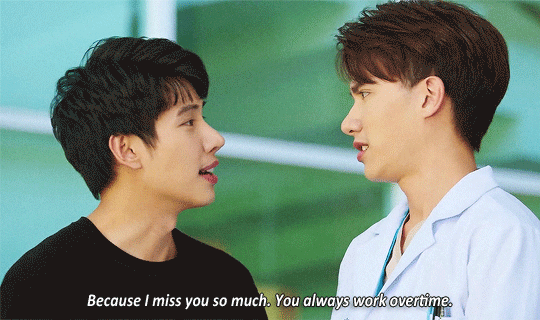
Representative Screenshot:
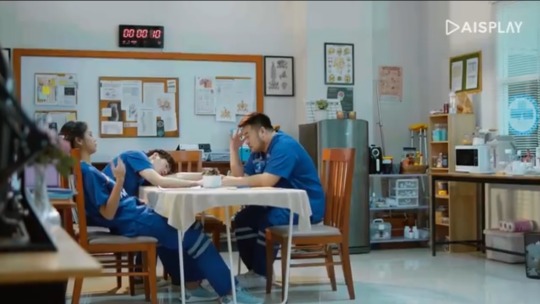
Watch It Or Drop It Masterpost
0 notes
Text
Toku Tuesday 55: Daniels
Hello my friends! It’s a Tuesday, so that means we’re going to watch some films.
Tonight the theme is director duo Daniel Kwan (關家永) and Daniel Scheinert, who got a lot of buzz recently for their multiverse-blending scifi film Everything, Everywhere, All At Once. Is it worthy of that buzz? Idk, let’s find out, I’ll probably write about it later.
They’ve been making short films together since 2009, and hopped into the feature film side of things in 2016 with Swiss Army Man, featuring a third Daniel, Daniel Radcliffe, as a farting corpse who washes up on a beach and soon turns out to have a bunch of strange powers. Here’s a trailer for that movie:
youtube
Hopefully the music in this trailer is deceiving and it won’t try too hard to be Inspirational. The premise does sound inventive and funny, and it is amusing to see Radcliffe still going for the most grossout hardcore roles he can find to shake off the association of, well, you know.
Six years on from that, the Daniels are back. Everything, Everywhere centres on martial arts star Michelle Yeoh who got her start in Hong Kong ‘heroic bloodshed’/‘girls with guns’ films (c.f. TT#32) such as Yes Madam, and later became internationally famous through the wuxia film Crouching Tiger, Hidden Dragon - definitely something we need to cover on one of these nights.
Yeoh plays Evelyn Wang, who makes a meagre living running a laundromat, but abruptly discovers, while on the hook at the tax office, that she can connect to thousands of alternate possible versions of herself from different branches of an Everettian modal realist multiverse - and that there’s some kind of major multiversal threat which she has to call on these powers to face. Ultimately it’s basically about existentialism.
Here’s your trailer!
youtube
Multiverse films have been pretty popular lately, and much like Into the Spiderverse a few years ago, it sounds like this film uses the alternate branches as a collection of genre pastiches:
The film has been described as a "swirl of genre anarchy",[4] featuring elements of martial arts films, science fiction, fantasy, action, and animation.[5]
The film was apparently ideated for some decades, inspired by reading about modal realism, and has no connection to Spiderverse etc. Regardless, it’s a fruitful set of ideas to go into - undetermination, the factors that are common to every ‘iteration’ of a person, creating meaning and purpose out of nothing. (’Home stuck’ you say? Uh. Haha. Never heard of it.)
In the interests of securing more hours for drawing and painting, I’m not going to be giving a detailed writeup this time. However, I did recently read an interview about how they structured Everything, Everywhere around the famous kishoutenketsu structure that’s nigh-universal in Japanese storytelling (ironically, while their inspiration Miyazaki increasingly found it constricting and pushed away from it in his later films, says AniObsessive who made me aware of it). They say the usual things: that kishoutenketsu is about change rather than conflict, which I still find a bit dubious, but you know...
As a consciously ‘Asian-American’ film, in Daniel Kwan’s own words, the directors relate that much of the writing process involved 'leaning in’ to the large pile of stereotypes about Asian characters in American films; the goal being to take these stock characters and add more dimension to them, and expand the image of their core actors beyond the types of martial arts films they’re broadly known for. Kwan says:
“Early on,” Kwan explains, “Someone asked me, ‘Why are you making an Asian American film about kung fu? Why do you have the main characters live and work above a laundromat? Shouldn’t we be moving beyond that?” He takes a deep breath.
“And it struck me in a funny way. Because, yes [we should], but also this is my life! Am I going to allow a stereotype that has boxed me in my whole life—to force me off my own story? To decenter myself from this story? This is a film rooted in how I grew up, and the stories I grew up on,” he continued. “That almost became a call to action, a clarifying moment. After that, I decided to lean in even harder.”
The interviewer, Linda Codega, heaps praise on the film for the way it ‘expertly, lovingly deconstructs’ such concepts. I admit a certain wariness any and all discussion of ‘deconstructing tropes’; at best it’s often oblique to what’s actually interesting in a story, at worst self-congratulatory. Nevertheless, it does sound like this process pushed them to put a lot of consideration into the character writing, and the nigh universal acclaim sounds like they nailed it lol.
What of the actual action in this action film? (To pretend that there is something resembling tokusatsu in Toku Tuesday anymore.) This is pretty interesting actually: the film has a lot of pretty impressive VFX shots, but this was achieved with a tiny team of just five people on a pretty thin budget. That video really skims over the details, but their tricks included things like speeding up footage of walking around New York, LED screens to help match lighting, small-scale greenscreen compositing, pushing the actors around in a wheelbarrow while they act in slow motion, as well as a lot of tight editing and jump cuts.
As for the martial arts choreography, that comes from a pair of Youtube stars: Andy and Brian Le of the channel MartialClub, as related in this article. They consciously made homage to the Hong Kong martial arts film lineage which Yeoh was used to; the scenes apparently involve unlikely props like butt plugs, and there’s some cute production stories like Ke Huy Quan only landing a certain move on the second take.
This all seems like a very 2020s sort of film, in short: canny digital production techniques using After Effects and practical effects to create something that looks very ‘expensive’ on a small budget, self-aware reappropriation of films past, the invitation of filmmakers who got big making free content on Youtube. (The same trends you see in mediums like animation with ‘webgen’ animators increasingly filling anime credits, bands like Mili who made their name on the web performing OPs, independent animators like Vewn being given their own shows, not to mention all the adaptations of web novels and webcomics.)
So, that’s the plan tonight: at the very least Swiss Army Man and Everything, Everywhere, and if possible I will also try to track down some of the Daniels’ short films. We’ll start around 8pm UK time at twitch.tv/canmom (when have I ever made 7pm? Best to stop pretending, I think.)
In the meantime, canmom theatres are going to be playing Elden RIng for a bit and then working on this nsfw animation commission for a couple hours, if you fancy joining this afternoon~
18 notes
·
View notes
Text
i do think that i do think that plays and comics have common ground in terms of adaptations yeah this is about gnomeo and juliet and spiderman but it's also about everything. an inherent part of the genre is reimagining things and recreating things and different interpretations different iterations. every time a play is performed it's different. comic characters exist in so many forms. there is no "true" original existence. yeah that's true for all media in consumer interpretation but comics and plays exist in a way that requires reinterpretation over and over before consumers even consume it. it's like in the epigenetics revolution by nessa carey she uses a script as an analogy for genetic code and how each cell will express that differently through epigenetic modifications which work like a director's interpretation like an actor's interpretation like notes on the script etc it's not quite the same for comics but they do exist in a way that means they are constantly reimagined and changed. if you are adapting it you're adapting it based on other ways you've seen it adapted and how you viewed that and how others have reimagined it already before you reimagined it. find the essence of the characters and go from there. find the essence of the story and go from there. reimagination is inherent in the media type. and that's why gnomeo and juliet is the best romeo and juliet adaptation and the amazing spiderman the best live action spiderman adaptation
3 notes
·
View notes
Text
tidbits from the Fellowship of the Ring director + writers’ commentary track (feat. Peter Jackson, Fran Walsh and Phillipa Boyens)
the prologue, and issue of how to work all the exposition about the Ring into the film, was a source of great difficulty for the writers and went through a lot of iterations. in some versions of the script Gandalf would have told Frodo the story of the Ring in Bag End as he does in the books. at one point they decided to scrap the prologue altogether, only to get a note back from New Line that they had to have it, so Peter, Fran and Philippa had to assemble it from the existing footage they had while they were in England putting the soundtrack together.
the framing of the prologue and exactly what information would be in it also went through a lot of changes before it was ultimately decided that it needed to be from the 'perspective' of the Ring itself since the Ring is in a way a central character in the story. at one point the narration would have been done by Frodo, from the perspective of him writing the book after the quest was over, but it was felt that he didn't have the necessary perspective to make it work and that an immortal character like Galadriel worked better.
although prologue!Bilbo is only seen for a few seconds, costume designer Ngila Dickson meticulously made sure his outfit matched the descriptions given in The Hobbit, including the brass buttons on his waistcoat that he later loses while escaping the caves.
the population of Hobbitton in the opening was mostly recruited from farmers and people living around Matamata, where the Hobbitton exterior set was built. two of the hobbit extras later got married after first meeting on set.
the shot of Sam with the flowers in the extended cut is the only time in the films Sam was actually shown gardening.
the shots of Frodo greeting Gandalf were done with four actors--Elijah Wood, Ian McKellen, a small scale double for Frodo and a large scale double for Gandalf. when the closeup is on Gandalf, Ian McKellen is interacting with four-foot-tall Kiran Shah. when the closeup is on Frodo, Elijah Wood is interacting with almost-eight-foot-tall Paul Randall.
while many of the scale shots of the hobbits are actually done using very simple techniques, Peter Jackson chose to invest time in a few impressive ones early on so as to help really sell the idea for the audience from the beginning. one of these is the shot of Bilbo taking Gandalf's hat and staff as Gandalf enters Bag End--it was actually a very complicated shot that involved making big and small versions of the props and then carefully merging them together with CGI.
most of the Bag End scenes were shot by filming the actors on two different sets, a large-scale one for Ian Holm's scenes and a small-scale one for Ian McKellen's scenes, and then merging them together. however the scene of Bilbo serving Gandalf tea was done with both actors on the same set and used forced perspective--there are actually two tables of different sizes lined up to look like one table, with Gandalf interacting with the larger table and Bilbo with the smaller one.
Gandalf hitting his head on the ceiling was an unscripted accident left in because it worked so well.
before including Thorin's map from The Hobbit in Bag End, the writers made sure to double-check where the map canonically wound up in the books. they gave the task of researching this to Henry Mortensen, Viggo Mortensen's son and a diehard Lord of the Rings fan.
Peter Jackson expected to get pushback from the studio about the amount of smoking in the film, and in particular was ready to have to fight to keep in the scene of Gandalf and Bilbo smoking before the party. however no one ever brought it up at all.
most of the hobbit actors in the party were friends and relatives of the cast and crew. although the books state that Bilbo invited 144 hobbits to his special table, "due to budget constraints" the actual amount of hobbits at the party is probably closer to about 100. viewers are advised not to count them too closely.
some of the hobbit children listening to Bilbo's story were played by Peter Jackson and Fran Walsh's own children. one of them, Billy Jackson, was the only actor in the movie not wearing a wig, because he already had "naturally perfect hobbit hair."
the "Proudfeet!" shot was framed as a homage to Ralph Bahksi's animated Lord of the Rings, which was what originally got Peter Jackson into LOTR.
during Bilbo's speech, the polystyrene birthday cake had so many candles on it it actually caught on fire and started to burn. the take was going so well, though, no one wanted to interrupt Ian Holm, so the cake is just sort of quietly burning away in the background while Bilbo talks.
the seventeen-year time skip in the books had to be compressed in the movie because they needed to get the story going quicker and keep up momentum. Gandalf's appearance when he comes back to Bag End is meant to imply that he's even more disheveled than usual because he's ridden pretty much nonstop all the way to Minas Tirith and back.
the scenes of Gandalf in Minas Tirith were the first time Ian McKellen had been in his Gandalf the Grey costume and makeup for months, as when those were shot he had been filming as Gandalf the White for some time.
there was discussion about using subtitles onscreen to identify locations, since there was worry that audiences would have a hard time following all the different places seen throughout the movie, but ultimately it was decided that this might feel too cheesy so it was dropped.
the voice of the Ringwraith that shows up in the Shire looking for Bagginssss was done by Andy Serkis.
the Green Dragon scene was cut for time in the theatrical release, which Peter Jackson was disappointed by both because it was a chance to see the main hobbit cast in their 'natural environment' before the adventure really starts, but also because it demonstrated the hobbit tendency to be gossipy, insular and distrustful of the outside, a trait they had some difficulty getting across in the films.
the full Ring poem is never heard in the movies; the filmmakers wanted to get it in there and at one point it was recited in full during the Council of Elrond, but it wound up being cut.
the Ring 'speaks' with Sauron's voice at certain moments to try to emulate the sense of psychological horror and dread associated with descriptions of the Ring in the books, which was very hard to replicate on film.
in one very early draft of the script, Merry and Pippin would have been introduced when they were caught eavesdropping on Frodo and Gandalf along with Sam.
Jackson chose to shoot the duel between Saruman and Gandalf as physically as possible because he didn't like "wizard fights" in movies "where old guys shoot lightning out of their fingers at each other" (gotta disagree with you there Pete).
Billy Boyd offered to use a Gloucester accent for Pippin instead of his natural Scottish one, but tended to lose some of his comic timing while doing so. it was decided that the Tooks had enough of a Scottish vibe that the natural accent worked better for the character anyway.
the shot of the hobbits falling off the cliff was one of the first things ever shot for the series. it was also the cause of one of the few serious accidents during filming--one of the stuntmen dislocated his shoulder during the fall, apparently just as a freak accident as the stunt itself was not especially dangerous.
the scene where the hobbits first meet the Black Rider looks like it's in remote wilderness somewhere but was actually shot in a park in the middle of Wellington.
the insects coming out of the ground while the hobbits are hiding is meant to convey the idea that everything living tries to instinctively flee from the Ringwraiths, but Jackson admits he isn't sure if that came across well on film.
the Buckleberry Ferry almost sank between takes and had to be saved with bilge pumps.
like Bag End, the Prancing Pony set was built twice, once at normal scale and once at large scale to film the hobbit actors on. some of the people seen walking past the hobbits in the backgrounds are actually on stilts.
the basis of the Ringwraith scream sound was provided by Fran Walsh screaming while suffering from a throat infection.
no real trees were harmed during the scene of the Isengard orcs chopping down Fangorn Forest: it was two fake trees shot from different angles as they were pulled down.
the question of whether it was appropriate to reference tomatoes in the Weathertop scene (since they are new world vegetables) was apparently a source of some contention among the writers. Peter Jackson was of the opinion that in a movie with a Balrog, a tomato should not strain suspension of disbelief that much.
the fight scene with the Ringwraiths on Weathertop was the first thing Viggo Mortensen ever shot for the films, and also the first time he'd ever used a sword.
the scenes of weapons being forged in Isengard were shot in a foundry and the molten metal seen being poured is real molten steel, because they couldn't come up with a convincing way to fake the appearance of molten metal. the workers at the foundry were recruited to play the orc extras in the scene.
Lurtz was created to provide a kind of 'face' for the Uruk-Hai as well as to be a villain that could physically confront the Fellowship at the climax, since both Saruman and Sauron stay within their respective domains and, aside from Saruman's scenes with Gandalf, don't actually directly interact with the protagonists.
replacing Glorfindel with Arwen is acknowledged as taking a big chance, but the writers were already struggling with the sheer amount of introductions to new characters in the film and didn't want to introduce yet another new character only for him to almost immediately disappear from the story again.
filming the chase scene between Arwen and the Ringwraiths was interrupted by massive flooding at the location. the cast and crew took a break from filming to help shore up Queenstown with sandbags.
when Gandalf escapes from Isengard, Saruman is holding his staff with one hand because Christopher Lee had injured his other hand smashing it in a hotel room door and couldn't hold anything with it.
the scene of Sam and Frodo in Rivendell talking about going home was a pickup shot after the main filming was completed, which is why Sean Astin is noticeably thinner there than for the rest of the movie--as soon as principal photography was completed he dropped all the weight he had gained for the role.
Elrond sounds especially deep and harsh while talking to Gandalf about the weakness of men because Hugo Weaving had a bad case of flu at the time.
the Council of Elrond took 6-7 days to shoot and was "a nightmare" because of the difficulty of keeping track of the eyelines of so many people sitting in a big circle.
Sean Bean occasionally glances down during the "one does not simply walk into Mordor..." speech because he has his lines written on a piece of paper in his lap; the speech was given to him so soon before filming that he didn't have time to fully memorize it.
when Gandalf reacts to Frodo volunteering to take the Ring to Mordor, Peter Jackson told Ian McKellen to imagine that he had just heard his son volunteer to join the Army in World War One.
38 notes
·
View notes
Photo
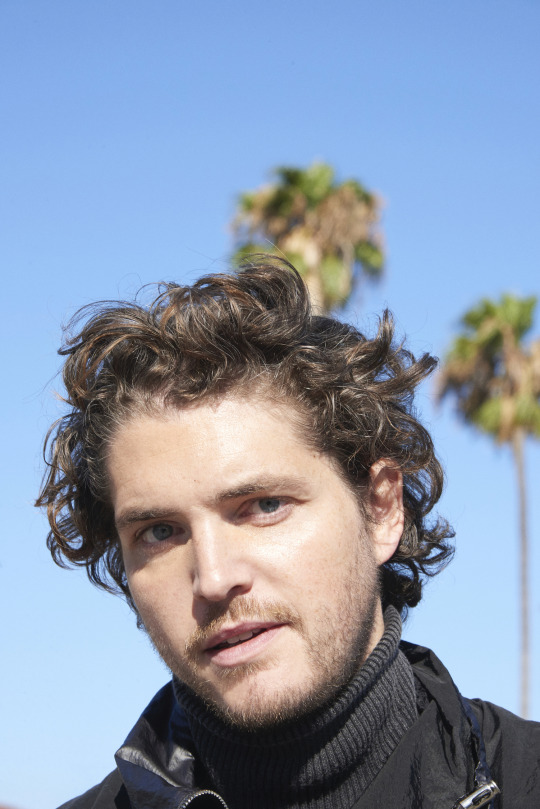


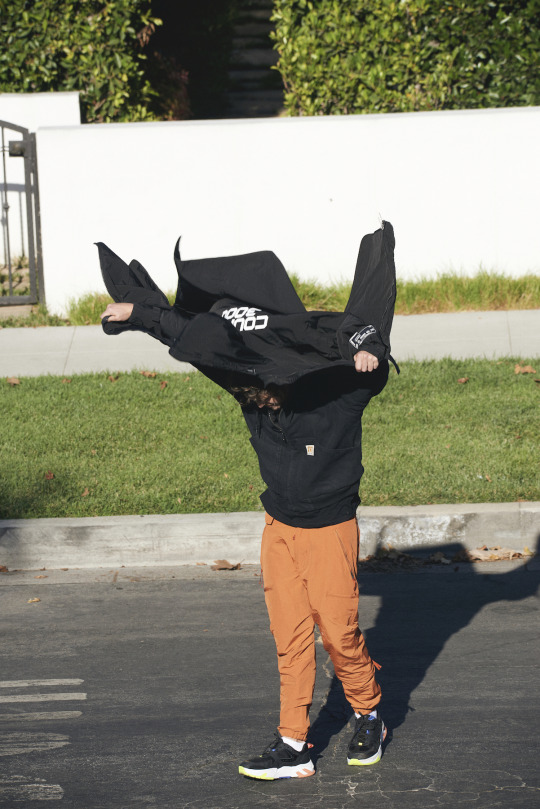

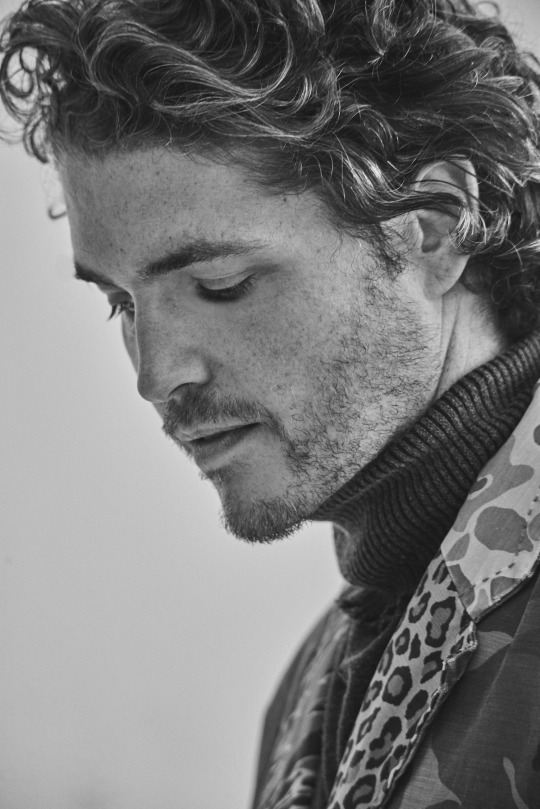

PHILIP ETTINGER
in HBO Series I Know This Much Is True
PHOTOGRAPHY Mark Squires FASHION EDITOR Deborah Ferguson
Interview by Sydney Nash
Philip Ettinger is an American actor, whose credits include starring alongside Ethan Hawke and Amanda Seyfried in “First Reformed” and “The Evening Hour,” which debuted at this year’s Sundance Film Festival. Ettinger’s most recent project is HBO’s “I Know This Much is True,” helmed by director Derek Cianfrance and starring Mark Ruffalo. Based on Wally Lamb’s acclaimed novel by the same name, it tells the story of the complicated relationship of two brothers (twins), one of which lives with paranoid schizophrenia. Ruffalo stars as the older iteration of the twins, while Ettinger inhabits the two characters in their youth. ContentMode spoke to the actor about the limited series and arguably, his best performance yet.
Q: Before we dive into questions about I Know This Much Is True, I must first say, bravo. This show is visceral, heart-wrenching, and achingly beautiful. It was a very emotional experience watching, I must say. I’m curious as to the type of feedback you’ve been hearing from viewers and the people around you about the show.
A: Thanks for saying that. This project is so close to my heart. It felt super emotional shooting it… it’s been really special. You know we’re going through such a fucking crazy time right now. You make a thing and have that whole experience of shooting it, and then you never really know how it might connect in the time of when it’s finally released. When I’m working on something, I’m so much in the state of not even thinking of it as being a product. Then, when it’s time for it to come out, it’s a bit of a mind fuck and scary. And this in particular was such a vulnerable experience. Everyone gave so much of their heart to it. It’s being released in a really crazy and heavy time, and the show deals with a lot of real and heavy things. But what’s been amazing is the people who have reached out to me to tell me how important it’s been to them. And how much of an emotional balm it’s been. People have vulnerably shared with me how this show has made them feel less alone in their own unique situations and emotions. Honestly, it’s been fucking beautiful to see how much we all can relate and share in the really difficult work of being a human being.
We’re all connected. It’s been a nice reminder for me personally in this isolating time of quarantine.
Q: Tell me about how this role came about. I know you’ve been a long admirer of Mark Ruffalo’s work, so this must have been a dream project.
A: The whole thing just feels kind of kismet. One day, I get a random email from a friend of mine who was going in to audition for young Dessa (younger Kathryn Hahn). This was before I really knew anything about it. She forwarded me her appointment with the script and said, “You should be young Dominick/Thomas.” All of young Dessa’s scenes were with young Dominick/Thomas, so I was able to see what it was like.
I’ve always looked up to Mark and have been compared to him in the past. I even wrote him a letter when I was in acting school and doing This Is Our Youth, which was the play he did in New York, and I expressed to him how much I connect to his work. He was doing Awake and Sing! on Broadway at the time and I went to see the play and gave him the letter. On top of that, I grew up with a brother who dealt with schizophrenic symptoms. I felt a really strong purpose to tell this story as real and accurately as possible. It’s rare when it happens, but sometimes things come along where it’s much deeper than it just being a job. The purpose for doing it is so strong and instinctual that I’m able to move through any fears or insecurities to do it. I went into this audition with a really strong sense that I was the person who was meant to help tell this story.
Q: Did you and Mark ever prep for the role together? I’ve read that you and him took a long walk around the Upper West Side before shooting started.
A: Yeah we did. The way it worked was Mark shot all of Dominick first and then took a month and a half off to gain about 50 pounds in order to play Thomas. During that time off is when I shot most of my stuff. We would text back and forth with ideas and before shooting began we hung out and read each other’s scenes together. Then Mark went off to shoot his Dominick side. Derek Cianfrance our director showed me a bunch of Mark’s dailies for me to kind of get a sense of what Mark was doing with Dominick, but when it came to Thomas, I was the first one to introduce what he’d be like. It was fucking scary because I wanted to be as instinctual as possible and to make my own unique choices. At the same time, I didn’t want to paint Mark into a corner because he’d have to evolve whatever I was doing into older Thomas.
About a week before I went to shoot, I met Mark on the Upper West Side at a diner. We talked for hours. I had been waiting in the wings for months, getting ready to take over when he took his break. I can be a pretty obsessive thinker, so at that point, I was pretty much bursting holding these two distinctly different characters inside of me, ready to express myself and let my Dominick and Thomas out. At the same time, I was absolutely terrified because the thing I’d been obsessing about and literally having intense symbolic dreams about was finally going to happen. Mark encouraged me to make it my own, and on the way out of the diner, I started to tell him about these crazy and intense dreams I was having that were kind of informing me who these guys were. He said, “I’ve been having dreams too. Let’s take a walk,” and then we just walked like 50 city blocks. We were just meshing our energies, ideas and physicalities, as well as sharing stories and quickly connecting on a really vulnerable level to each other. We were having very similar dreams. It was crazy and beautiful and a night I’ll always remember. Talking about it now makes me yearn to get back into more collaborative experiences again.
Q: If you don’t mind me asking, how emotionally intense was performing the roles of both Dominick and Thomas? Did you find one character more challenging than the other and were you able to separate the two performances, or were they always informing the other?
A: It’s hard to really describe it using words. The whole thing was one big instinctual and emotional experiment. It was kind of impossible to anticipate the best way to make it all work.
First day was completely trial and error. Mark shot each character separately with a lot of time apart, but I was having to do every scene going back and forth. The whole thing was very out of body and cathartic. Or more like in my body and out of my head.
It’s interesting, I’ve been doing therapy in quarantine and have worked a bit with childhood regression exercises and going back to a time when I was four or five. I’ll go back on impulse and really connect to the feelings I was feeling without too much awareness of social rules and insecurities and ideas of how I needed to be and act. Then, doing the same thing, but going back to the thirteen year old version of me, who at that point had been knocked around a bit and was very insecure and shut down and scared and had less trust and freedom of emotion. Both of them are very alive inside of me. Shooting every scene, I’d be Dominick and feel really repressed and kind of locked up and angry and insecure in my feelings. Then when I’d switch over to Thomas, I got to rip off the shield and filter that I’ve created to personally protect myself in my life and just feel my feelings and pain and fear and anger and fully be on my impulse in a safe environment. It was freeing and painful and blissful, and all of the feelings. I gave myself permission not to judge myself. Then, I’d go back into Dominick and the shield went back up. It was a lot of back and forth of that.
Honestly, it’s impossible to really explain it in retrospect. It was like one giant therapeutic experiment. It definitely changed me and gave me some different perspectives.
Q: Did you ever feel like your acting influenced Mark’s performance or vice versa?
A: It felt like one ongoing collaboration. We were taking from each other from the preparation through the shooting. But there was an ease to it all, which just shows how generous Mark is as a human being and artist. He didn’t have to invite me in the way he did. I’m very grateful for that.
Q: What was it like working with director Derek Cianfrance? Did Derek allow you to bring your own experiences and POV to your characters?
A: Derek is my emotional soul brother. The guy has so much fucking heart and just sets up an atmosphere of trust and love and challenges you to go deeper than any ideas you may have and to find the truth of every moment. He wants you to bring all of your heart and soul to the part. He’s done so much work and has thought so deeply about the characters and the scenes, but then challenges and almost expects you to surprise him. It’s all about, as he says, ‘trying to capture Halley’s Comet in every scene.’ Something that’s straight from impulse and truth and surprising and spontaneous and can never be exactly recreated. It’s all a big experiment and diving into the truth of every dynamic and relationship.
That’s exactly the way I love to work, so it was just a fucking dream to play like that.
But in order to work at that level, you need to have such trust in the leader and it needs to be such a safe environment. With Derek, I just felt so safe.
Q: Tell me a little bit about how filming two characters on-screen at the same time worked. How much of what the audience sees when Dominick and Thomas are together is CGI?
A: It’s crazy. The editing is incredible. Other than a few connecting shots, many of the scenes the two brothers are never in the same shot together. I think Derek wanted to make it feel as natural and un-CGI as possible, so he relied on the performances to connect the dots. The response has been that it feels pretty seamless and not a distraction, which is great to hear. We all definitely tried to avoid the trick of it all and really cared about making each brother his own three dimensional being.
Q: The show was shot on film as compared to digitally. What’s the difference that shooting on film makes to the final product and the audience experience?
A: It’s awesome. It was my first time shooting on film. There’s a heightened intensity to it all, because there’s a limited amount of time before the film rolls out. It’s exciting. I tend to work best and am able to commit more when adrenaline is a little higher and there’s a little more pressure. There’s also something more tactile about it all. It feels more activated and felt like we were shooting a movie instead of a TV show.
Q: I’ve read in other interviews where you’ve spoken about how your relationship with your own brother (who has a history with schizophrenic symptoms) influenced your performance. Can you tell me a little bit about this (if you don’t mind sharing)? How important was authenticity to you?
A: My brother is doing great now. It’s amazing. But there was a long time when I was growing up where he was suffering. I watched him struggle through a lot of thoughts and emotions inside of his head. On the flip side, he was probably the most honest, empathetic and connected-to-the-energy-around-him person that I knew. And has deeply affected how I see things in a really special way. I also watched my parents try and understand and protect and deal with it and help. And do the best that they possibly could under the circumstances. They were amazing. But I also watched them struggle and make questionable decisions in order to help in the only ways they knew how. I was also having my own experience.
What was so important to me about this show was to be able to express all sides of the situation and the nuance to it all. Often, when there’s mental illness in a family, everyone is doing the best that they can with the tools that they have. Sometimes the “crazy” one is the most tapped in and actually present and intuitive and available. Sometimes the ones, who on the surface have their shit together, have no idea what they are doing.
I think this was a way for me to express myself and better understand what repressed feelings I had having a brother with mental illness. One thing’s for certain: I don’t think anyone involved was interested in anything but navigating the truths and realities of these situations.
Q: Based on your own experiences with your brother, the director Derek added in a scene to one of the episodes. Can you elaborate on what this scene was?
A: Yeah, I told Derek a bunch of stories about me and my brother. There was a period of time when he was around 22 and in the midst of a mental break. I was around 9, and we shared a room. Some of the stories were scary, but a lot of them were really funny and beautiful. I observed my brother be so present and tapped in to the energy and people around him. Sometimes his thoughts would get away from him, but almost always, the impulse of the thought and the intuition he would have was so on point. It made me feel like he was often more present and truthful and sane than so many other people around me who seemed to be repressing, overlooking and complying to the rules of society and the pressures of fitting in and saying and doing the right and popular thing. I felt like he really took me in and saw me better than anyone else.
I told Derek about how often my brother’s energy felt so expansive and truthful to his feelings that it would be infectious to the people around him and magical to me. And then Derek added a scene in episode 4 where Thomas is feeling a lot of emotions and the best way he’s able to express himself is through unadulterated dance. It’s a moment that Dominick watches on and knows he’d never be able to be so free in his emotions to express himself like that. [Derek] told me he added that scene inspired by the stories I told him about my brother.
Q: At its core, the show is about the relationship between two brothers, but the show touches on so many different enduring themes. What about the story speaks most strongly to you?
A: We’re all trying to get through life in the best ways that we know how. We all have unique family situations, life expectations, and struggles and pains on different levels. The show and Wally Lamb’s novel just touches on what it’s like to be human and the possibility for growth and change when it may feel like it’s impossible. As he says, “But what are our stories if not the mirrors we hold up to our fears.” And another quote that seems to resonate more than ever: “With destructions comes renovations.”
Q: You must be very proud of this show and the reception it’s receiving. How did you feel seeing the finished product?
A: It feels a little surreal to watch. It’s hard for me to fully take in my own stuff or to judge it good and bad, but what I will say is that there’s so much heart in the show and I’m forever proud and grateful to be a part of it. And to watch Mark and Rosie and Kathryn and John and Melissa and Archie and everyone else and feel so connected to them. And to have my family watch it and have it inspire new conversations between us. It feels very healing in a lot of ways.
Q: Moving forward, what types of roles are you hoping to pursue? What’s the most important aspect of a project to you?
A: I don’t really know. I want to continue to work with people who inspire me and to feel a purpose with what I’m doing beyond ego and expectation. And to keep doing stuff that really scares me and to ultimately just find things that will help me evolve and gain some different perspectives. To continue to do things that make me feel connected and out of my own head.
I’ve been lucky to be a part of a few things where everyone involved is connected and on the same page and doing it for the right reasons, and the material is strong and every once in a while, when all those stars are aligned you can have moments of transcendence absent of ego and fear and judgement and you’re just riding on your impulse and intuition and heart. I want to keep chasing that.
Q: With the world in the midst of a pandemic and social unrest, what are you most hopeful for?
A: How connected we all really are even though the world feels divided right now. There’s so much pain and fear and anger right now, but there’s also a lot of change happening. And beauty. If there’s any silver lining to all of this loss, pain and suffering, I think it’s that it’s forced us to be more present with our families and loved ones. And maybe break some habits that we’d never be able to break on our own. And slowed things down a bit. And forced us all to look inward and to take a pause from all the fast and constant external validation so many of us think we want or need. I’ve witnessed thousands of people coming together to support each other and to stand up to injustice. This time has been traumatic on many levels for everyone, and I’m sure there will be long term effects of that, but also I’m excited to see the positive effects and positive changes this time may cause. In a way, it felt like we needed a bit of a reset and recalibration to really make some changes.
Quick Qs
Q: If you weren’t an actor, what would you be?
A: Maybe a therapist? I’m endlessly fascinated in why people do what they do and how they do it. And don’t do things. And why. And the relationship between our conscious and unconscious bodies and minds. And the potential of evolving our thought patterns past or through our blocks and pain and traumas. I’ve also spent a lot of time working one-on-one with autistic kids and adults, so maybe that. Something to do with human behavior and connection and growth and expression. Or if I was taller and more athletically gifted, it would be pretty damn cool to be an NBA basketball player.
Q: Role model?
A: Literally anyone who’s able to get through life with continued kindness, open-heartedness, positivity and evolution.
Q: Pet peeve?
A: People giving advice to other people based on what they would want or how they would act or react, instead of taking in the other person’s perspective.
Q: Most slept-on movie?
A: This is not particularly slept on, but this conversation and question is making me think of The Devil and Daniel Johnston.
Q: The last thing you binged?
A: I’m a novice TV watcher. This past year and during quarantine is the first time I’ve really caught up on shows. Recently I’ve gone through Mad Men, The Affair – Maura Tierney’s so good in that. I just watched Normal People. I thought Paul Mescal was such a subtle and good actor in that. Oh, and In Treatment. I love In Treatment. I just heard that they may be bringing it back, which is exciting to hear. The nuances of two people in a room talking for a long time really does it for me.
Q: Dream role?
A: Hamlet? Even though that scares the shit out of me and seems to be a cliche’d answer for an actor my age.
Q: What’s the best advice you’ve ever received?
A: To try easier. It’s not necessarily the amount of time spent working, but more the quality and headspace of that time.
Also, to stop trying to control the outcome of what and how I think I want something to go. Because guaranteed it won’t go exactly as planned and trying to force what I think is the best thing is quantifying and limiting the possibilities of what it could be.
And something that I saved that Mark actually said to me:
Hang tough, stay real, make your shots count when you get them and no matter what, keep moving. Just keep moving.
_______________________________________________
For remaining photographs from the Content Mode article, scroll down to the next post.
(I am archiving this entire article here, because I have no idea whether or not the Content Mode site will continue to host the Ettinger interview in the future, as more is published there in time. No copyright infringement is intended.)
8 notes
·
View notes
Note
How did you create your characters? What was your process?
TMI Tuesday: How did you create your characters? What was your process?
// <offers out a chair> You’re going to want to sit for this. It’s going to be a LONG story. For those who’re looking for a short answer: I’m actually in the middle of creating these two. Edits and tweaks are always being made to make them appear real and true. And it’s thanks to everyone on here and in-game that they’ve progressed so much.
Now for the long version.
<buckles seat belt>
Evolving as an Author:

Maxinora and Augustine Parkhurst are a culmination of ideas inspired by a myriad of things. The process of creating them isn’t linear. It has a lot of pit falls, unexpected twists and turns, and a ton of hills. To understand how we got the current versions of these two, we need to go back a couple years ago.
It’s the summer of 2012. In efforts to get me off of his account, my Dad gifted me my own. This was when I made my first ever serious roleplay character- a hunter named Evelon Holmwood. Well, at the time I spelled it like Evavllyn but...Yeah. We’re going to gloss over that fact. Now, Eve was my pride and joy for the last several years. I played this character nonstop, refusing to play or write about anyone else. In retrospect, I used this character more as therapy than anything of creative merit.
Eve’s story was basic at best. But I got better with story-telling the older I got. Unfortunately, her story got so convoluted that I had hard time salvaging anything from it. Now, you’re probably asking: How does this relate to Max? Fear not. I’m getting there. It was around this existential crisis that a mutual friend of my boyfriend and I convinced us to leave WoW and hop on SWTOR. My boyfriend was more than eager to make the switch but I was skeptical. Leaving WoW meant leaving Eve. And was I ready for that?
He assured me I was and helped me make a character on SWTOR. This was the first iteration of Max. A bounty hunter from Nar’Shadda named Maxinora Fenrik. My intentions was to make her a lowkey copy of Eve. At this time, I wasn’t very confident in my writing abilities and liked to stay in my lane. But, the more I roleplayed this character the more she took on a life of her own. She evolved past Eve and exceeded my expectations. Playing a new character bolstered my confidence and while I no longer play SWTOR -due to OOC reasons- I still have fond memories with this character. I enjoyed this character so much that I reused several components of her design when making Max. Some which include her name and being blind in one eye.
I flipped between the MMOs when Legion dropped. Expenses started to pile up and between the two subscriptions I didn’t have the time to play both. In the end, WoW won my affection and I made a Blood Elf because I had friends on Horde Side. Rorien Hawkthorne was her name. A drunk artist and master assassin. She’d be the second iteration of Max. She had an older sister complex, an affinity for being melancholy, and it was my first experience with playing a character who could kept secrets- or tried to at least. Another new character under the belt and I was feeling a little more confident in my story telling abilities. I’d probably would’ve kept playing that character if not for OOC drama happening in a guild I was in. The fallout had me jump back to the Alliance where I indulged in creature comforts. It was back to Eve.
Tumblr made an entrance in my life around then as I ventured forth with a refreshed look on my hunter. I salvaged what I could and made a half-decent story. A lot of her misadventures are still posted up on her blog @evelonholmwood On the side I made the third iteration of Max. A fire mage and blacksmith combo by the name of Rowan Celwick with her younger brother Thomas Celwick. They were just two orphaned kids trying to make a life in Stormwind. Rowan was an arcane drop-out and blacksmith wannabe and Thomas...Was...Well? Thomas? A glorified side-piece? A way to garner pity for Rowan. I didn’t place a lot of emphasis on them or their characters. My main focus was Eve. But these two would be the underlying foundation of Max and Auggie’s characters.
I eventually took a hiatus from WoW and focused on more personal writing. The details are boring so I’ll gloss over it by saying that creating a character completely from scratch was the final push in the right direction for me. Fast forward several months to a year aaaaaand BOOM! Pandemic.
Writing is an escape for me. It’s one of my best coping mechanisms during trying times. And when nothing else works, I over indulge in some Warcraft. So, I resubbed. There was hesitance when re-entering the RP scene. I didn’t leave Eve’s story off on an convenient note. For lack of better phrasing, I wrote myself into a hole I couldn’t get out of. So, with the help of my boyfriend, I decided it was time to give Eve her happy ending and shelf her for good.
Which put me in a dilemma! Who was I going to RP? Well, you remember the Celwicks? They became my newest project.
The Creative Process:
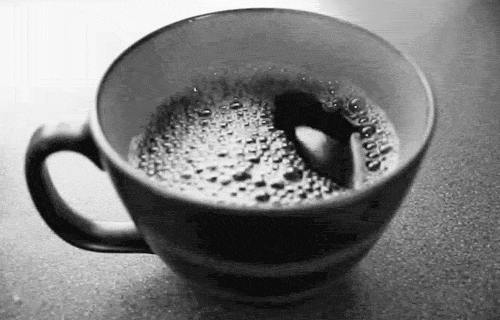
I knew the Celwick story was weak and read much like a middle-school fanfiction. Revising was a must. But there were integral pieces to their story which I enjoyed:
Familial Sacrifice
Juxtaposing concepts
Intertwined Fates
These were themes I could work with and evolve. Keeping these in mind, I started to deconstruct the Celwick story line. They were no longer Gilnean but Kul’tiran. This prompted a name change from Celwick to Parkhurst. And I won’t lie, I like the sound of Parkhurst better than Celwick. Thomas became Augustine and Rowan became Maxinora (Mainly because I actually HAD the name Maxinora and not Rowan). The little changes got me hyped for the characters.
Next, I started to trim away the unnecessary details that bogged down the narrative. Things that either didn’t fit or made the timeline too convoluted were replaced. Pyromancy was a great example. The age I wanted Max to be wouldn’t yield to her understanding of Pyromancy. At least, not to the level I WANTED it to be. SO, I turned it into lament’s magic. Alchemy. (I also always wanted to play an alchemist since watching FMA)
A girl with two professions seemed excessive as well. I had to look at why I wanted her to be both an Alchemist and a Blacksmith. The answer was simple. I just liked the juxtaposition of an intelligent woman being rough and tumble. Which made me ask: Was Blacksmithing necessary to achieve that imagine? The answer was no. To pay respect to her previous iteration, I made their parents blacksmiths. It also let me keep themes of fire in her concept. The change in profession brought on a change in her appearance. I made her a little more slender to fit with the alchemist appeal.
Max’s aesthetic was brought on by my previous characters. Rorien inspired more internal facets of Max while Fenrik inspired outward appearances. Max’s auburn was strictly a decision made on the fact that I had one too many character’s with black hair. There wasn’t any other reason for it.
Designing Max was easy. The real challenge was with Augustine. Up until that point, all I had to go on for his character was Tommy Celwick and...Well. There wasn’t a lot there. He wasn’t much more than a poorly used trope and I considered doing away with him all together. But I realized that I REALLY liked the trope and I liked what he did for Max’s character. So, I buckled down and made myself think through all the reasons why Thomas Celwick -AKA Augustine Parkhust- needed to exist.
I decided that I needed him in order to present themes in Max’s story. He was the foil to her character. Cynic older sister? Meet optimistic brother. He also appealed to not only the three themes listed above, but also the newest one I wanted to explore: two sides of the same coin. Max and Augustine are simultaneously the same, having similar traumas, and yet different. If for nothing else, Augustine could help propel Max in the right direction. Be her moral compass, you know? With a bit of half-assing here and there, I managed to get a decent character out of Augustine. Took the cliche nerdy brother idea, physical design and all, and ran with it. Shortly after I made their Tumblr account. In no way did I expect this BOY to take on a life of his own. Like, Auggie knocked on my brain’s door and was like, “Yeah. No. I’m not a side character. Give me my own story...”
Which will bring me into my final point!
The Characters Write Their Own Story:
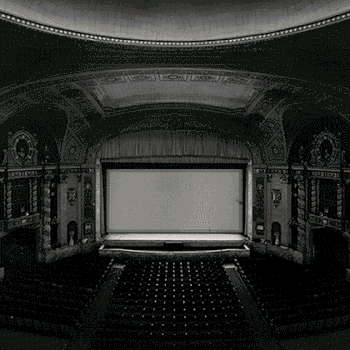
I’ve never been able to sit down and plan a story. My mind doesn’t work in such a structured fashion. It wanders and explores. When I’m creating, I’m watching. Watching the scenes play out before my eyes as these characters take what I’ve given them and grow into something almost independent of me. The basic pieces of Max and Auggie’s back story, along with character design, were purposeful. Yes. But everything that came after was THEM.
It’s cliche, I know, but I can’t describe this experience any other way. These two grew outside of my influence and now dominate a space in my brain. They talk, work, and interact without me. I mean...Not REALLY. But...It feels like that. It feels I’m watching through a keyhole and just recording what I see as their story plays out.
I guess a better analogy is me being the director. I’m watching the movie in the stands as two actors improv. On good days, I’m in control and rework scenes until I’m satisfied with the results. Try this. Move here. Say this. On bad days, I don’t see anything. My actors went home. The lights are off. Show’s cancelled for the day. These days make me sad...But they’re worth it because on the BEST days...The best days Max and Auggie run the whole show, and I am watching through the keyhole as their story unfolds little by little.
It’s truly magical.
The last part of their creation was the voice. Character voice, for me, is like building muscle. You need to work out. Start small and work your way up in weight. Every little piece I wrote made their voices stronger; and that’s including asks and threads. Interacting with other characters helped to flesh them out as people. And while it was hard and intimidating at first, it’s started to become easier.
Wrap-Up
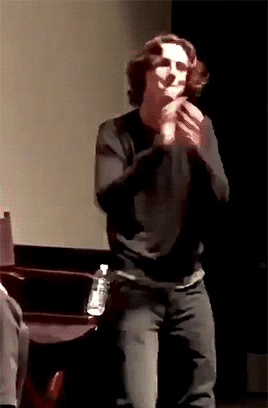
My method is messy and untrained. I don’t claim to have any secrets. My knowledge of writing is mediocre at best. But I’m having fun. And that’s were the real magic of any character comes in. Fun. Because if you aren’t writing about something that sparks your soul- either with love, happiness, hatred, etc- then it’s nothing more than a forced, hollow husk. Writing is meant to evoke emotion. At least in mind. And want to express complex emotions and share them. In a perfect world? My characters -any of my characters- resonates with someone. They become the escape someone needed. That’s the ultimate goal.
It’s thanks to all of you that Max and Auggie have come this far. It’s from their interactions with others that they’ve managed to evolve into something incredible- especially Augustine. He just kept shining brighter and brighter until I felt obligated to make him an in-game character. So, you all are just as much a part in the creative process as me. Thank you!
And a special thanks to my boyfriend for always being a sound board for my rambling ass <3
THANK YOU FOR THE ASK, ANON! Sorry I posted an essay...<3
14 notes
·
View notes
Text
158. porky’s romance (1937)
release date: april 3rd, 1937
series: looney tunes
director: frank tashlin
starring: joe dougherty (porky), berneice hansell (petunia, babies), mel blanc (excited petunia), billy bletcher (time munches on narrator)
i’ve been looking forward to reviewing this since the day i first typed my review for bosko, the talk-ink kid. so you’ll have to excuse me for rambling on more than normal, i’m really passionate about this cartoon. there’s so much to say!
first off, this cartoon means a lot to me. it’s the first one i checked out on my own accord. i caught wind of who carl stalling was and wanted to listen to a piece of his music to familiarize myself. i saw his depression era compilation of music, and included was the opening number for this cartoon, which absolutely blew me away. i looked up the cartoon and watched it and instantly fell in love. porky was fat! porky has a different voice actor! porky was INTERESTING! porky was killing himself! i had never seen anything like it, so it holds a special place in my heart. i had a vague idea of some directors, like bob clampett and chuck jones, but had no idea who the hell this “frank tash” guy was. but after watching it, i knew i’d love him. and i do!
secondly, this is joe dougherty’s final appearance. while mel is undoubtedly the better porky, i’ve really come to appreciate joe. he gets a hard time because he had a real stutter, and one of the repeated criticisms i see is that it sounds too overdone. true as that may be, he couldn’t help it, and i applaud him for working as long as he did. i mean, a little over 2 years, that’s a decent amount of time! and he does have talent. we’ve seen and heard much worse. so i’m a little sad to see him go, but excited at the same time knowing wonderful things are ahead. i love this particular era in looney tunes history, the porky’s romance to, say, porky’s badtime story era. there’s this sense of newness and freshness—new voices, new characters, new directors. you feel the change happening before your very eyes. it’s all so exciting!
i’ve rambled enough, and i’m certainly going to ramble much more, so buckle up! after petunia pig rejects porky’s marriage proposal, porky seeks a noose for comfort. when the suicide attempt goes wrong, he’s then launched into a dream sequence about their potential marriage life... and realizes marriage isn’t all it’s cracked up to be.
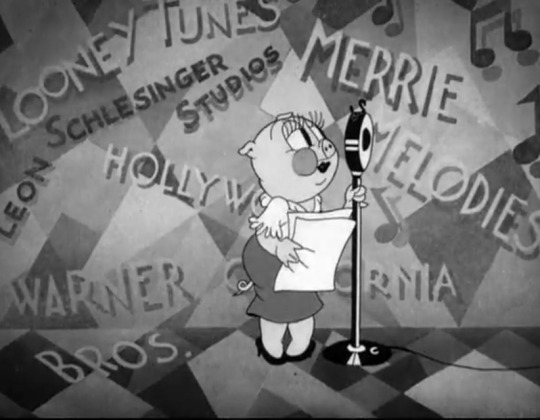
this cartoon has a unique opening to it. before the title card itself, we are presented with “leon schlesinger’s new looney tunes star: petunia pig!” curtains draw to reveal petunia positioned in front of a microphone. yes, this is petunia’s first appearance! she has quite an interesting history. she appears only in 3 frank tashlin cartoons, where she was depicted as a sultry, sexy foil for the bumbling, not very sexy porky. bob clampett would adopt her in 1939 and make her to be much cuter, giving her hair and a much more naïve demeanor. she hardly has any cartoons at all, yet somehow managed to live on through the dell looney tunes comics and in future looney iterations.
petunia greets her audience warmly, opening with “my public! i hope you pictured my liking--i mean, i hope you lictured my picking... i mean... i--” overcome by nerves, petunia struggles to read the script in front of her and greet the audience. this little bit was inspired by the short lived 1936-1937 radio program community sings. the offscreen announcer attempts to calm her down. “shhh, petunia. don’t get excited, don’t get excited...” petunia’s furious outburst (vocals by mel blanc, of course) of “EXCITED!? WHO’S EXCITED?? I’M NOT EXCITED!!!” comes from comedian professor tommy mack, who would do the same slow routine and then the explosion with the “WHO’S EXCITED?” line. tashlin’s the woods are full of cuckoos is an entire tribute to community sing.
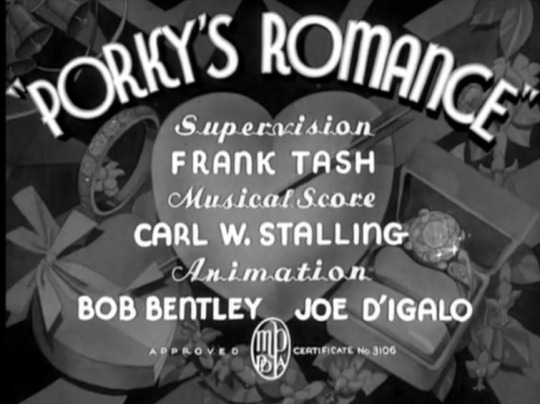
the curtains close on petunia, and then we’re actually greeted with the title card. an absolutely stellar rendition of “i wanna woo” underscores the title and the opening scene. a happy porky whistles along to the music as we have a montage of him buying necessities for petunia. a diamond ring, some roses, some chocolates. what a good guy! i love the visuals in this cartoon. everything is so sleek and modern--it’s evident tashlin was enamored with the art deco style. and that song again is just beautiful--it’s why i investigated this cartoon in the first place!
porky finishes his routine as he approaches petunia’s house, dancing up and down the stairs before ringing the doorbell. i love that face of his as he poses by the doorbell, throwing his bouquet in the air and catching them in his hand. he’s awfully full of himself.
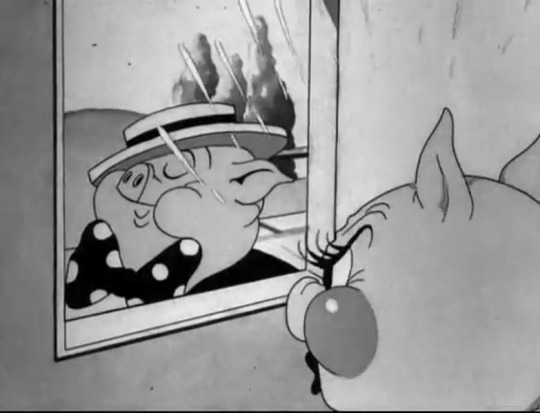
inside, petunia approaches the door, her brat of a dog fluffnums by her side. for some reason, fluffnums was attempted to be pushed as a reoccurring character, with model sheets and drawings of him surfacing around the studio, i guess for publicity, but he only appeared in this cartoon. same goes for the iceman in i only have eyes for you (his name is sammy sparrow?) and the parrot in i wanna be a sailor. petunia opens the top portion of her door to see her visitor, and we see cocky old porky posing with his hat hilariously tipped on his face. petunia, for whatever, isn’t very pleased, turning her nose and marching away, stomping her foot. “porky pig! pooh-pooh!” in the same rhythm, the dog barks the same amount of syllables, stomping its little paw. warm welcome.

a lovely, downtrodden chorus scores porky as he trudges away tearfully, wilting, pausing only to kiss petunia’s nameplate on her house. suddenly, fluffnums looks out the window and barks for petunia. “what is it, fluffnums?” then, petunia spots the box of chocolates porky carries along behind his back. we then get this BEHEMOTH of a scene that displays how tasteful of a director frank tashlin is: 6.5 seconds, 157 frames, 10 cuts. petunia rushes out of her house at the speed of light and urges porky back inside her home. the scene has CLARITY--you can understand what’s happening, unlike the rapid cutting in porky in the north woods. this scene is genius. petunia throws a dazed porky on her couch while she gorges herself on the chocolates, cooing about how glad she is to see him.
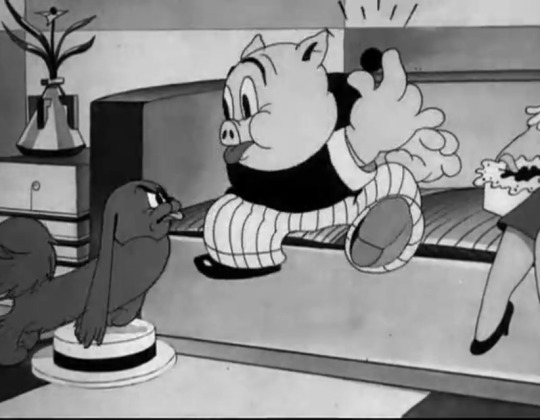
mark kausler identifies the animator as volney white (though the thick eyebrows make me think of bob bentley. mark’s a wonderful source of information i gladly accept everything he says, because he’s right 99.9% of the time) for the scene where porky tries to reach for a chocolate himself. fluffnums, ever the threatening guard dog, growls. we have a great back and forth scene as porky sheepishly pets the dog on the head, reaching for a chocolate and still getting growled at. the charade continues until porky finally snatches one, sticking his tongue out in childish defiance at the dog. as porky lifts up his trophy, winking towards the audience at his act of outsmarting, the dog jumps up and eats the chocolate himself, breaking a hole in porky’s boater hat in the process. (no dogs were harmed in the making of this cartoon!)
seeing as this is joe dougherty’s last cartoon, he doesn’t speak very much at all. in this scene, the animators had porky facing AWAY from the audience so they wouldn’t have to animate his lip movements. it was pretty clear that everyone was tired of working for dougherty. instead, porky’s body jitters as he speaks. they used a technique called staggered exposure, which was mixing up a sequence of drawings to get that jittery effect (so instead of going in a sequence of 1, 2, 3, 4, 5, 6, 7, 8, 9, 10, and so forth, it would be more like 1, 3, 5, 7, 9, and so on.) “why petunia, i want you... you.. you to.. be in love.. that is.. um.. will you.. uh... er, uh.. may i.. that is... won’t you... will you... aw, shucks. will you marry me?”
just as porky finally manages to spit out his confession, disaster strikes. petunia’s bastard of a dog pulls the carpet out from under porky, sending him flipping and falling in the air. because of this, petunia ridicules and laughs at him. porky is now absolutely devastated, leaving petunia’s house for good. i love the detail of his ears and bow tie wilting. carl stalling’s music is on point in this cartoon: an underscore of “the little things you used to do” backs up the scene here. that song was sung at the end of the coo-coo nut grove, where the entire nightclub was flooded in tears.
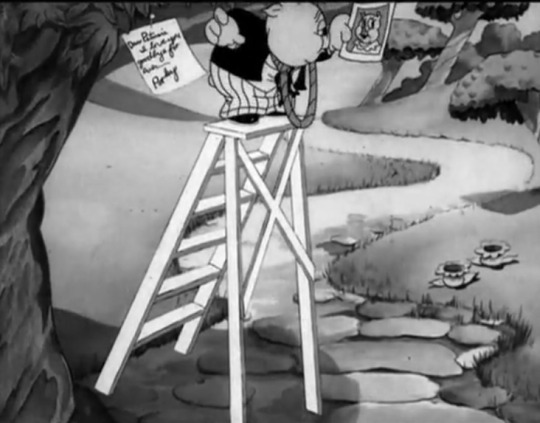
the next scene is strikingly somber and surprised me greatly the first time i watched it. we iris in on porky writing a suicide note, a noose tied around his neck, tied to a tree branch. the note simply reads “dear petunia, i love you. goodbye forever -- porky” the camera panning out is a little janky and rough, but i digress. porky wipes away his tears, pulling a photo of petunia from his pocket and giving it a kiss. with that, porky jumps.
because of his weight, the suicide attempt fails as the tree branch breaks, porky toppling to the ground and hitting his head. thus launches a dream sequence as his surroundings spin around (by unscrewing the lens of the camera, screwing it (counter)clockwise in front of the aperture), melting away to the exterior of a church. wedding bells chime victoriously. inside, petunia and porky give their vows. porky struggles, stuttering “i d-d-d.... i-d..d-” the officiator whistles (a dougherty era running gag), and porky spits out his final “do.”
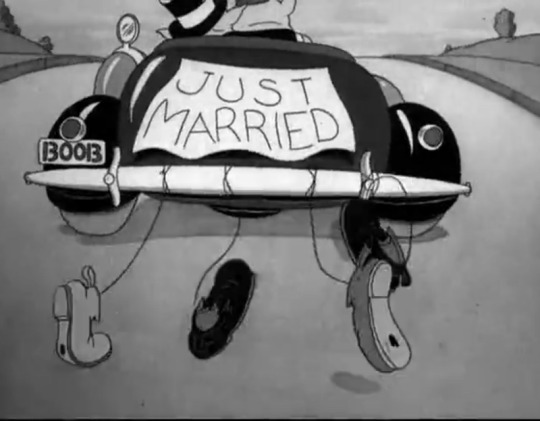
more volney white animation as the lovebirds exit the church, waving to the crowd that surrounds them. and, of course, fluffnums is there too, begrudgingly carrying petunia’s veil in its mouth. we cut to porky and petunia happily riding in their car, a victorious JUST MARRIED banner waving in the wind, with shoes attached to strings on the bumper marching along in time to “in my merry oldsmobile”. porky’s license plate reads BOOB -- a good indicator of how frank tashlin felt about porky.
a lovely overhead layout of the honeymoon hotel porky and petunia stay at (with, of course, an underscore of “honeymoon hotel”, which was also the title of a 1934 earl duvall merrie melody). the elevator rises to the top floor in syncopation with the music. a nice silhouette shot of porky and petunia, and rather suggestive at that. they kiss, and the last we see before a fade out is porky turning off the light in the apartment.
billy bletcher voices the narrator as a triumphant fanfare blares. “TIME... MUNCHES ON!” rather disconcerting eating noises, and then we open to a very rotund petunia and fluffnums gorging themselves on chocolate. not the most flattering depiction of a woman, but the ironic “laughing” of the clarinets and horns playing “oh, you beautiful doll!” is a wonderful touch. i love when the scores themselves serve as jokes.
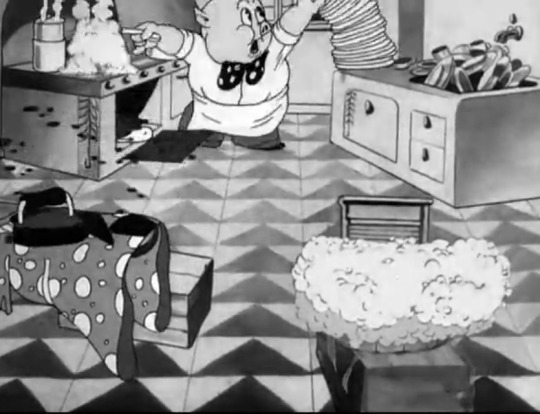
pan across the apartment, the score melting into another rendition of “i wanna woo” as we see poor porky hard at work. i adore the layout of this entire scene. porky busies himself with all the odd jobs petunia has (presumably) thrown onto him, washing the clothes, ironing a dress, cooking the food, washing the dishes. he unsuccessfully attempts to balance the chaos, trying not to kill himself in the process. pay attention to how the furniture is arranged. the stove, the sink, even the ironing board, they’re all slightly diagonal and at an angle. practical? absolutely not, no one has their furniture arranged like that, just jutting out. but in animation terms, it’s more than practical. it’s so that you can see the details clearly, so that you can see every little thing happening. the clarity of the scene would be muddied if the furniture was arranged the way it should be--you may miss details like the pan burning on the stove or the looming pile of dishes. this is some super smart staging, and the architecture is just beautiful within itself. porky struggles to keep up with the demands, but fails, burning food, clothes, etc. you’ll notice that when he fails to balance a pile of dishes, the china crashing into him as he flops down on the floor, whatever he’s cooking in the pot boils over as well. everything just explodes at once.
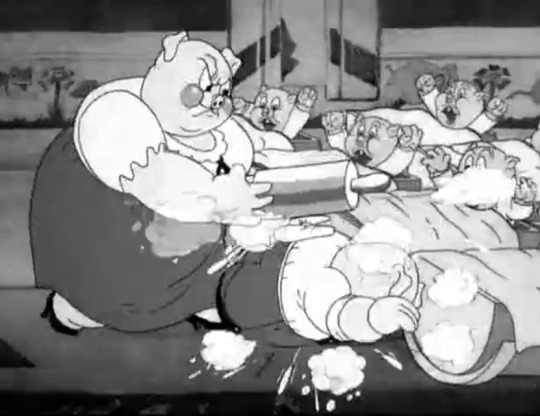
meet porky pig jr, porky pig jr, porky pig jr, porky pig jr, porky pig jr, porky pig jr, porky pig jr, porky pig jr, and so on. all of the babies start screaming at the noise (bob bentley animation), and petunia puts in her two cents by yelling “porky pig! shut those kids up!” porky rocks one of the cradles back and forth, reassuring her “i’m doing the best i can, petunia dear.” petunia marches forth, wielding a rolling pin as she retorts “don’t dear me, you WORM!” with that, she beats porky relentlessly over the head with the rolling pin, all of the kids shouting “GIVE IT TO HIM, MAMA! GIVE IT TO HIM!” which is another radio show catchphrase of some sort.
finally, we’re met with reality. porky sits in a daze on the ground, petunia stroking his cheek with fluffnums at porky’s other side. petunia puts on her best sympathy act, cooing “oh porky, i’m so so-ree! you’re my honey man. i’ll marry you, darling, honey bunny boo...” while petunia showers porky in all sorts of pet names, he looks up at his suicide note, remembering his dream where petunia was an abusive slob. they had trouble with the camera movements again--when they came out of the dissolve, the camera was in the wrong position slightly, creating a double image.

this is one of my favorite endings to any looney tunes short. a terrified porky jumps up at zips away into the horizon (with that great electric guitar zoom/twang sound effect i love so much), petunia shrugging and fluffnums making a ! mark appear over his head. suddenly, porky retreats, snagging his chocolates from petunia and running for the hills. a beat... and he returns once more, only to give fluffnums a well deserved swift kick in the ass. the music score in this scene is just lovely, nice and jazzy. the timing is succinct, and i love the guitar zoom sound effect. iris out.
as you can see, i love this short, a lot. while i love the blow out, i think this is my first true favorite that we’ve seen so far. it’s so dark, and i don’t even like dark stuff! it just feels so different. carl stalling is in tip top shape with his music scores. every single piece is lovely, especially that beginning. the animation is fun, the expressions are great. i wish i could articulate my thoughts better, because i really just love this cartoon a lot. i’m super happy it was one of the first i had seen, because i probably wouldn’t be typing these reviews had i not. frank tashlin’s cinematography is STRONG in this one. the camera cuts, the angles... this is a beautiful cartoon, inside and out. i feel bad that it’s joe dougherty’s last appearance, but understand at the same time. great things are ahead, revolutionary things! i’ve warmed up to joe quite a lot. i’ve found nothing in terms of what he did after his tenure as porky--wikipedia (not reliable, i know) states that he attended medical school before becoming a voice actor, so good on him! anyway, i absolutely love this cartoon and have seen it multiple, multiple, multiple, MULTIPLE times. it’s strikingly different in tone than what we’ve seen and what we WILL be seeing. it’s not just your everyday frank tashlin porky cartoon. this one stands out, and i implore you to watch it.
link!
14 notes
·
View notes
Text
spam’s character design tips!
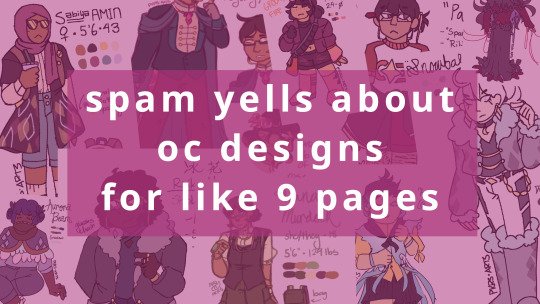
(various designs I’ve done! adopt characters belong to their owners, I only include them here as examples and claim no current ownership.) *disclaimer: it was 9 pages before i added pictures so i’m not inaccurate
If you would rather read this as a Google Document, please click here! (The document has more examples as well!)
Hey! My name’s Spam and I write Danganronpa: A Stormy Last Hurrah! You may also have seen my art for various stories and users around the Internet, including RATS: 252 Chances at Redemption and the Alca Ronpa series! You may ALSO also have seen my character designs, including those for ASLH as well as certain characters in Alca Ronpa and Kill the Joker: AnotheR Game! I sell adopts fairly frequently as well and have miscellaneous designs floating around the web, so I figured I may as well write something about my process. This is mostly oriented towards human OCs! So hopefully this helps someone!!
Before starting this guide, I’d like to give credit to gaiacseas/gokuhara’s “How I Design OCs: Do’s and Don’ts”! When I was designing the ASLH cast, I found myself coming back to this guide again and again. A lot of my points are the same as theirs, but I talk a bit about my own process, especially when it comes to characters that I revamp and redesign.
All uncredited art was done by me, including character designs. Characters belong to their respective owners. All other art is credited.
So let’s get started!
CONCEPTS
The first thing I’m going to say is that my character designs, especially those for myself, take absolutely FOREVER. I usually go through many, many pages of concepts and color tests before I find something I’m satisfied with. It’s a long and very constructive process, and if I’m designing a character for someone else, it can take weeks before we can find something we’re both satisfied with.
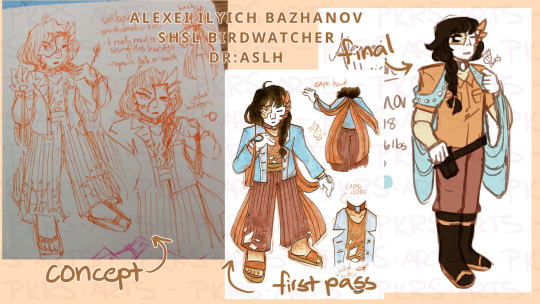
Alexei Ilyich Bazhanov, ASLH’s SHSL Birdwatcher, was a design-first character, meaning that I came up with his design first and built his personality around it. Although to be fair someone who constantly wears a feathery halfmask in public is inevitably bound to be kind of dramatic, so there’s only so many ways his personality couldn’t be influenced by his design. However, his design took a bit of a downgrade from his initial design to his current iteration, largely because of his initial design’s similarity to Tatsumaru Harai, ASLH’s SHSL Kabuki Actor.
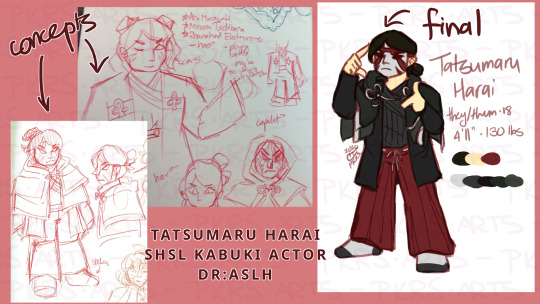
In Tatsumaru’s concept sketch, you can also see the inspirations I cited for their design! I don’t consume much media, so the characters I cite as reference are often OCs in my friends’ stories. Here, I cited Minami Tachibana (Danganronpa: Dead on Arrival), Alix Murasaki (Ultimate Danganronpa: Supernova at Sea), and… Rhanahad Electricrone (Alca Ronpa 2), for some reason. I… actually don’t remember how or why any of those influences connect to Tatsumaru at all? Actually, for almost all of the ASLH characters, I scribbled down some notes on design influences and proceeded to ignore them. So maybe don’t listen to me actually. But design influences are good! Just don’t straight up copy them.
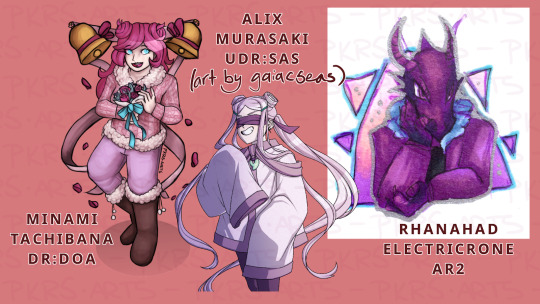
ANYWAY, as you can see, Alexei and Tatsumaru both had longish coats with balloon pants. However, I had better reason to keep these traits for Tatsumaru than Alexei, because kabuki acting actually uses these elements in its costumes. Thus, it made more sense to change Alexei’s design, although I do think that he would still actually wear that original outfit. It’s very himcore.
The point is that this ended up in many, many more drafts of concept sketches until I found something I was satisfied with. Like, six pages. It was kind of insane. It’s worth it in the end to make a polished product, though!
BODIES
(Admittedly, I’ll be the first to admit that I’m not the best when it comes to drawing distinct body types. It’s a weakness of mine that I’m getting better at, but I’m still not great at it.)
The #1 tip I can give here is to use shape language! This is what people use in pretty much all Western cartoons - ever think about how hard it would be to take Bill Cipher seriously if he was a circle? gaiacseas goes over shape language and silhouettes in far more depth in their tutorial, so I really advise looking at it! The basics are:
CIrcles/ovals convey softness and gentleness
Rectangles convey solidity and strength
Triangles convey sharpness and distrust
Combine shapes to modify the image your character conveys!
Also, just a tip: if you’re designing a cast of characters, please don’t just make them all the same body type! In real life, if you got any random sample of people, they’re not all going to be the same body type. Diversifying your body types helps a lot to distinguish characters from each other, too. Imagine if all of these characters had the same proportions as each other - even though they all have distinct outfits, you would have a much harder time perceiving them as different people.
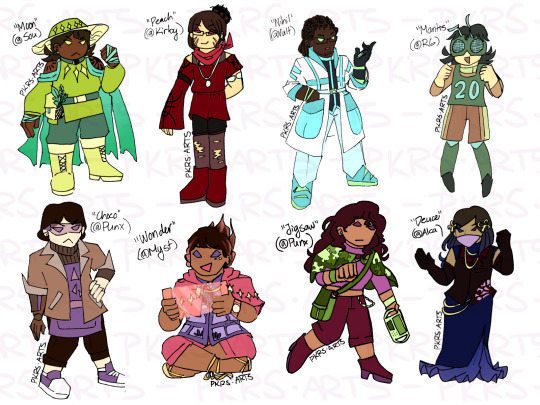
If you’re going to draw characters of a body type you’re unfamiliar with, good for you! But first, take the time to look up guides on how to draw those body types. Studying real people also helps a lot to understand the vast varieties of body types. Just look at this picture of Olympic and Paralympic athletes from the 2016 Rio games - there’s already a ton of variations in “muscular” depending on what their sport is, and each athlete is optimized to their sport! It’s like that for literally everyone on Earth with literally every body type. There’s millions of ways to be skinny (bony? lean? malnourished?) or fat (most fat around their stomach, arms, legs?) or muscular (tall like a basketball player, dense like a weightlifter?) so make them count!
Also consider making characters with disabilities! My commentary on this as an abled person is fairly limited, but I will say to please note that what you think you know about disabilities is not necessarily true. This is in regards to their experiences having a disability, but can even apply to things you don’t think about - the wheelchairs most wheelchair-bound people use are not usually medical wheelchairs, for example. Research!!
On a related note, please don’t make racial caricatures or draw all your characters with the same facial features. People of specific ethnicities tend to (but not always) have certain features that are common to people across a regional area, but that’s no excuse to veer into drawing in the same way old racist cartoons are illustrated in. Again, there’s plenty of guides to help with learning about these! Or just look at the people around you and draw real people as practice. You’ll find the world is much more diverse than you think.
And speaking of references!! I’ve seen a lot of really good guides these days for drawing different body types and features! Go check them out go check em go!!
sdkay’s guide on drawing different facial structures (original post was deleted)
kenzandfriends’ guide on drawing fat people (original post was deleted)
nsfwbutts’ guide on drawing fat people (guide isn’t nsfw but their blog is so this is a reblog)
mel-lion’s guide on drawing black features
chuwenjie’s guide on drawing East Asian faces
“world of averages” - composite images of thousands of portraits of people from different places (re: certain facial features being common to certain ethnicities!)
calvin-arium’s guide on drawing characters in wheelchairs
Honestly if you’re looking for help just literally google “how to draw [character trait] and I GUARANTEE you there is a guide out there for you. While people not belonging to the demographic you’re drawing will probably not notice if you don’t portray groups accurately, those who are part of that demographic will be absolutely delighted.
MOTIFS
Motifs are a really neat way to make your character stand out in a crowd, especially if those motifs have meaning behind them! I mostly do this for adopts, but one of my favorite designs was Ophelia Zhang, a character I designed and proceeded to do absolutely nothing with.
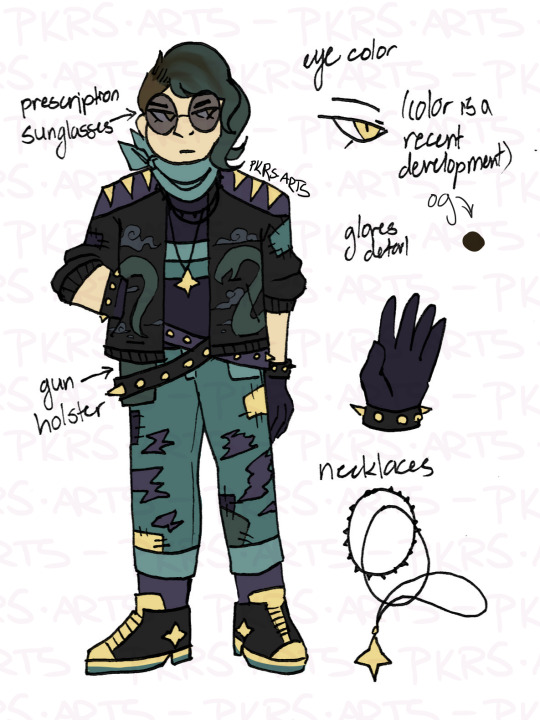
She’s Medusa-inspired, as is obvious because of the snake motif on her jacket and the green hair/yellow eyes combination! Maybe you didn’t notice it until I pointed out, but now that I did, it raises intrigue about her character and her connection to the myth, doesn’t it?
Aside from Ophelia, most of my (own) characters aren’t very motif-heavy, but I like having common themes and patterns that run throughout their outfits at least. It just makes the outfit blend better. Some examples of this include Claude Bates, ASLH’s SHSL Violinist, and Chiyo Kumoshita, ASLH’s SHSL Cellphone Novelist.

Nonstandards are a great way of making a character Become Their Motif! Claude is based on snakes, specifically grass snakes - he’s got beady eyes, fangs, a grass snake pattern on his pants, and the combination of weird vesty jacket thing and striped shirt creates a belly scales effect. HOWEVER, he’s also got violin motifs! Most obvious are the f-hole patterns on his coat, but a more subtle thing is that his shirt has 5 stripes - a music staff (which sheet music is written on) is made of 5 lines!
(“so spam shouldn’t he have only 4 stripes on his shirt, for the 4 spaces on a music staff” shut up i realized i messed up his design too late. my orchestra director is going to kill me)
Chiyo, on the other hand, has a distinct cloud motif! This primarily is to match her surname (雲下 are the kanji for “clouds” and “under” respectively), but the other reason Chiyo has a cloud motif is because of ASLH itself - ASLH is loosely themed around the Shakespeare play The Tempest, and Chiyo, being ASLH’s protagonist, gets a “clear skies” motif. Neat!
OUTFITS
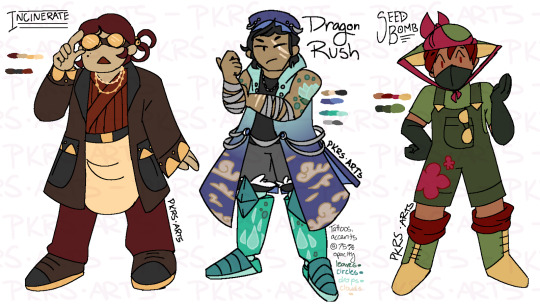
(“Incinerate” is the base for Puppet from Kill The Joker: AnotheR Game!)
There is SO MUCH that can be said about outfits and how I design them. The #1 tip I have is to look at what other people wear, and then decide what it is about that outfit you like so much! If you go somewhere where people are dressed differently from what you’re used to (a distant city or a foreign country), take notes! For me, some elements I come back to a lot include collared shirts, sweaters, oversized overdecorated overcoats, and cloud/sky patterning.
So here’s a little about what makes outfits distinct from each other!
Colors:
Bro this is SO IMPORTANT. There’s a lot that can be said about color theory, and gaiacseas says more than I do on the topic, but basically color conveys a lot about the character. Muted colors convey a muted personality, and brighter colors convey a brighter one! As gaiacseas says in their guide, however, this sets up a great way to subvert expectations about your character.
Protip! If you’re having trouble with a color scheme, just color pick from an existing picture! I don’t have any examples of this on hand, but I do know that sunset pictures are very yummy and I have a lot of pink/orange colored designs. Coincidence? I think NOT.
The number of colors you select is of course up to you, but personally, I don’t use too many individual colors for ease of creating reference images. Of course, realistically, no one’s going to wear clothes the exact same color as each other. Unfortunately for that realism, I am lazy and don’t want to color pick 10 colors, so this is how I live.
Layering:
This is the absolute #1 best way to build texture and silhouette in your characters! Step one, find a funky garment. Step two, find another funky garment. Step three, put them on top of each other. Step four, PROFIT.
The easiest garments to do this with is of course jackets, but they certainly aren’t the only garment that can be layered! Layering is just a matter of looking at clothes you would not usually wear together and going “I wonder what would happen if you wore this together?” In real life this is usually a disaster. But in the world of art and hypotheticals everything is fair game and NOTHING makes sense!
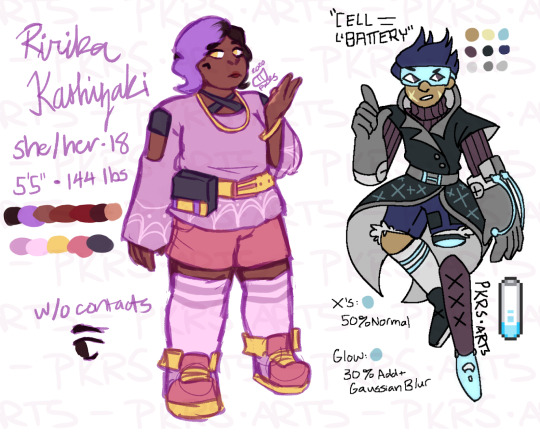
Patterns:
For when layers just don’t cut it! As far as patterns go, they could tie into motifs or just be a nice pattern. For example, Mal Jenkins is a painter, so the patterns on his sleeves, pants, and bag are based on Monet’s “Water Lilies”.
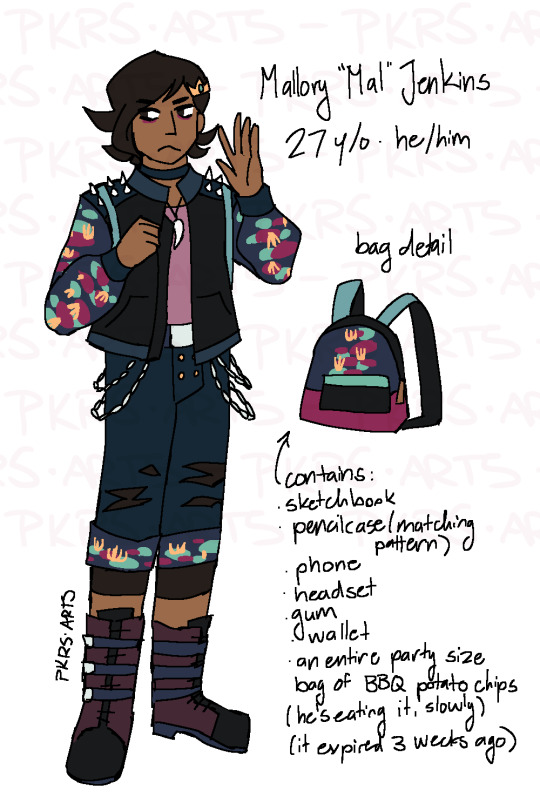
On the other hand, patterns could just be a pattern or recurring motif! The world is your oyster!
Materials/textures:
When combined with layering, clothes of different textures and weights can add a lot to a design! I mentioned before that I like designs with jackets, let’s look at a couple different hoodies! Featured here is Tristan McRae, ASLH’s SHSL Video Game Designer, and Hayato Kikuchi, Ultimate Parkourist (submitted to rebootmon’s Danganronpa: Zetsubou Panic!!).
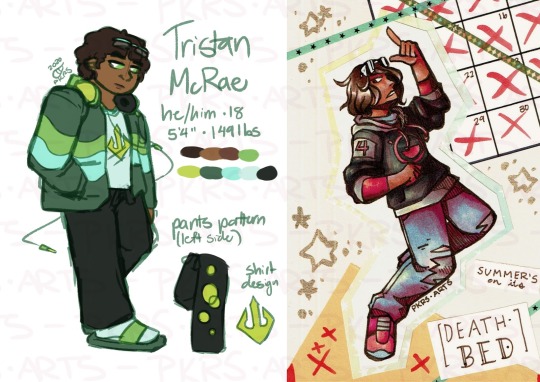
You can see that Tristan’s jacket is made of much thicker material than Hayato’s, which is very baggy and loose. This already makes their designs a lot more distinct from each other! (They’re also wearing totally different colors so that helps too.)
Other textures I like to do include adding holes (like Spring from KTJ:ARG has holes in her coat), adding things onto fabrics (like Tsukino Chisaki, ASLH’s SHSL Flight Student, has studs on her coat and boots), and adding visible stitching (like Brendan Valdez, ASLH’s SHSL Flight Student, has patches on his coat).

Clothes:
Having a general idea of what clothes actually exist is a very good start! Such as:
Tops: t-shirts, collared shirts, long sleeve/short sleeve shirts, tank/tube tops, cold shoulder shirts, blouses, sheer mesh shirts…
Bottoms: Skirts, gym shorts, denim shorts, jeans (with and without holes), leggings, culottes, kilts...
Dresses: Prom dresses, casual dresses, ball gowns, formal full-length gowns…
Undergarments: tights, fishnets, garters, long socks, short socks, gloves, bras/bralettes...
Coverings: Hoodies, cardigans, overcoats, denim jackets, capes, ponchos, vests, suit jackets…
Shoes: Slippers, flip-flops, sandals, high heels, sneakers, athletic shoes, slip-ons, boots...
Accessories: Hats, barrettes, hair ties, jewelry, bags, headbands, belts, chains, suspenders, buttons, glasses...
So from there it’s just mix and match! Keep in mind the different styles of clothing as well - you can swap out things like collars and edges to create variety! There’s different types of boots, different types of skirts, different kinds of bags. The sky’s the limit!
No, I Meant Like Clothes Inspiration:
Oh. Again, keep an eye out for specific art inspirations! If you see a cool character design or outfit on social media, bookmark it! Just remember not to copy clothes exactly, because that’s called art theft! I have a storage Discord server where I keep screenshots and links of art and outfits I come across while scrolling social media.
I find that the best original outfits are a combination of different outfits. Take certain elements that you find cool in each outfit , then add a few elements of your own and stick them all together! It might take a few passes to work as cohesively as you’d like, but keep trying! The best outfits that take inspiration should look so seamlessly blended and original that they should only look like the references if you compare them to each other.
I also have a few characters inspired by songs, so sometimes I’ll incorporate the motifs of MVs for those songs into their outfits. I don’t really recommend this unless you’re 100% prepared to be called out on where the outfit came from, and I ESPECIALLY do not recommend lifting the outfit exactly. Again, that’s art theft.
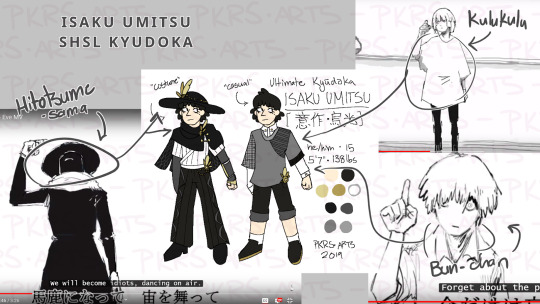
Isaku Umitsu, my SHSL Kyudoka, is based on the Hitotsume-sama, Bun-chan, and Kulukulu characters from utaite Eve’s music videos Literary Nonsense and Outsider. Looking at them side by side, the inspiration is obvious, but when taken out of context, it shouldn’t be the first thing that comes to mind unless you’ve watched Eve’s videos 100 times (like I have) (take my computer from me please).
References:
As for references! Here’s just a couple that I found digging through my Tumblr!
My main blog’s fashion tag!
moatdd’s layering how-to! This changed my life when I saw it.
OSF Costume Rentals - period accurate clothing!
leaf-submas’s hat and skirt style guide, feat. Napstablook!
Jfashionmagazines - Japanese street fashion!
If your mutuals have fashion tags or pages, that’s a good place to dig through as well! They almost certainly have different styles than you do, so you’ll get exposed to a lot of different styles!
Outfits are a lot of fun and my favorite part of designing characters! Hopefully it will be for you too! :D
REDESIGNING CHARACTERS/NEW OUTFITS
Ever got a character design you love, but then decided you weren’t feeling anymore? Or got a character from someone you ended up hating? Or you found character art from 5 years ago and decided you hated it? YEAH ME TOO TO EVERY SINGLE ONE OF THOSE!!
ASLH has four characters who were adopts: Ririka Kashizaki (SHSL Nail Artist), Sentarou Sekisada (SHSL Seat Filler), Hirono Ekyou (SHSL Oendan), and Ryouji Atsui (SHSL Caterer)! For a “complete from scratch redesign” I’ll be talking about Ryouji, who was converted from an attempt at design to a fantroll to an original design!
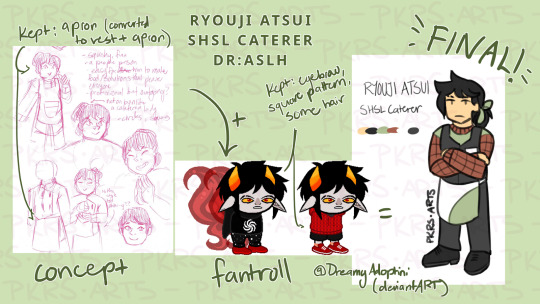
As you can see, I had a lot of trouble with Ryouji’s design. (It probably didn’t help that I didn’t finalize his personality until basically the prologue though lbr.) I didn’t really know what I was doing, and though I had the concept for the vibes I was shooting for, nothing seemed right. Around the same time, I bought an OC design from my friend Marti, and I was having so much trouble I was like “y’know what let’s just fuse the two”.
My process for redesigning OCs, especially when doing something like humanizing a nonhuman character, is to pick the certain traits I’d like to keep and change the rest. For Ryouji, the elements of his concept art I wanted to keep were parts of the outfit (the apron and vest) and the elements of the fantroll I wanted to keep were his eyebrow scar and the squares pattern on the jacket. Thus, when redesigning him, I made him have all of these elements! This was probably one of my favorite designs to make ever, and I’m really glad other people seem to like it too.
Weirdly enough, as soon as I finalized his design for his first reference, his personality almost immediately materialized. Which really just goes to show how much design can influence character personalities.
(Fun fact, drawing Ryouji’s reference was the first time I drew his final outfit, so I’m extremely grateful it turned out as well as it did.)
Other characters, like Hirono, only need a quick outfit touchup. I loved Hirono’s design already, and it fit with what I had in mind with her personality. All I did to change her was the same process I use to make any other outfit, see above. She’s an oendan, so she gets a hapi coat and school uniform… though, honestly, that original outfit is still super cute. I should draw it again sometime.
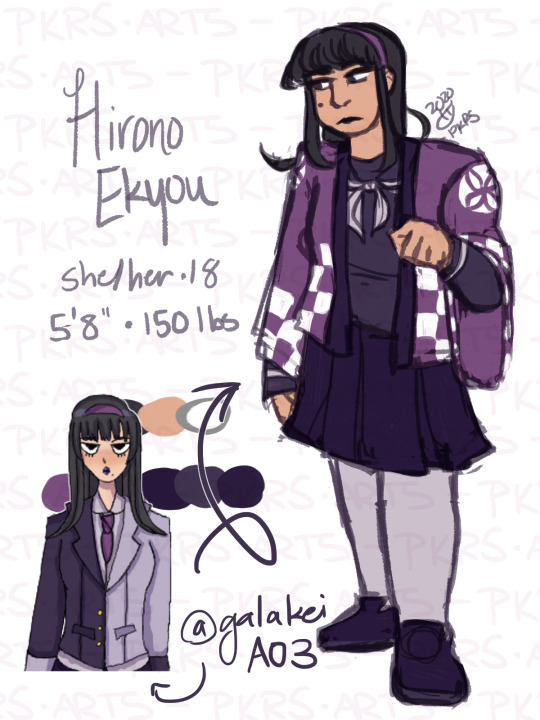
Most of the characters that I redesign as heavily as I did Ryouji are fangems and fantrolls that I buy from my friends, because I know that they understand my mighty need to redesign things. I try not to redesign adopts I get from other sources because I don’t know how the people I bought them from would feel about my editing their design too heavily; Sentarou and Ririka fall into these categories, so when I got them I mostly changed their outfits.
For me, it feels weird to redesign already-existing human OCs, but it’s also not impossible - Tristan, for example, used to be white. No I’m not going to show you the sketches for that and all you need to know is that it sucked, mostly because I was having a lot of trouble making him look nerdy but also nonthreatening. I think how he looks now is a good balance. If you ever get stuck redesigning a character, a race or gender swap (if either is possible tastefully) can go a really long way, and can even subvert expectations about a character! Just keep in mind dynamics and messages as well - if you have a strong violent woman and go “hey she should be trans”, that’s really not the best stereotype you would probably want to display in your work. Be mindful!
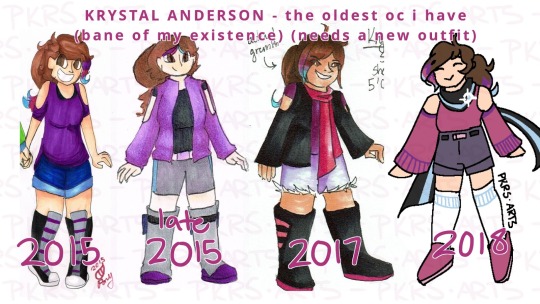
2015 (og design) => later 2015? (RWBY AU) => 2017 (AR3) => 2018 (DE:OPH
CAST BALANCE: DESIGNS
I wasn’t going to talk about this but then I decided I was gonna talk about it! I mean this is kinda a guide for Danganronpa characters, but this applies to any cast that is presented in a group. The characters in ASLH fall into a few different categories:
Created for beta ASLH: Chiyo, Amal, Tsukino, Ririka, Kanemori, Tristan, Tiana, Claude, Iris, Aster
Created for current ASLH: Ryouji, Sentarou, Alexei, Tatsumaru
Preexisting characters: Hirono, Brendan
The largest problem I had putting all the cast members together was revising outfits so that, as seen with Alexei and Tatsumaru above, designs wouldn’t be too similar. For the most part, I had vague ideas of what I wanted for each appearance; even the characters whose designs materialized fully-formed (like Tiana and Brendan) were edited slightly for cast cohesion.
I wish I could say I was responsible in developing all 16 characters’ designs at once so I could keep an eye on their design consistencies, but I would be lying. Instead, I finalized them and then posted them one by one. This was a double edged sword. One, I couldn’t go back and readjust colors or designs without making a whole new reference (which I actually did for Tatsumaru). However, because I was able to take a birds-eye view of my cast, I could see what design elements I needed more of - ESPECIALLY for color scheme! You’ll notice that a lot of the first row in my cast pic is very dark and grey-dominant, so I made a conscious push to include more colors in the second row of characters.
My one regret is not doing more talent-related designs. For a majority of the ASLH cast, you wouldn’t be able to tell their talent from appearance alone. In some cases this would have been impossible anyway (how do you convey to a Western audience a SHSL Cellphone Novelist through design?), but the only really distinct and obvious talent related designs are probably Tatsumaru (who probably doesn’t count because kabuki acting is maskless); Claude; Iris Sumitama, the SHSL Honors Student; and Kanemori Shionaga, the SHSL Football Player. Can you guess who they are?
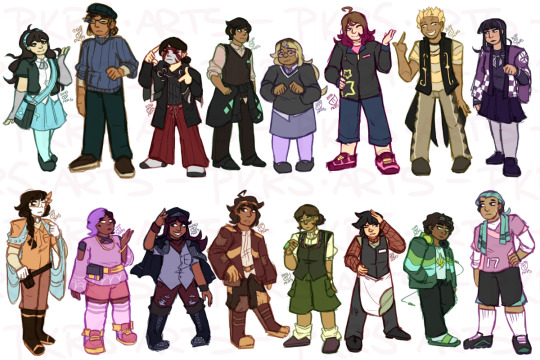
Also, Alexei’s outfit should have been more extra. I still regret not making it so.
TOO LONG, DIDN’T READ
Go look at gaiacseas’ thing.
I do at least a page or two of concept art before settling on a single design.
Pay attention to body types!
Motifs can make a character look really cohesive and thematic.
Pay attention to what you like in outfits, too!!
Color schemes give an at-a-glance idea of your character’s personality.
Layering creates distinct silhouettes and can be done with more than just jackets!
Varying materials and textures makes the same garments look distinct from each other.
Making interesting outfits is as easy as mixing and matching garments.
Find outfit inspiration, but don’t plagarize!
To redesign characters, take the elements you like and shift everything else until it looks the way you want it to!
Balancing cast designs is a tricky process; going one-by-one is possible but has its ups and downs.
A LAST NOTE
In general, when you make a character whose life is different from yours - especially those belonging to marginalized communities - for the love of GOD please do some research about the experiences those communities have. It is a very bad idea to make them into a mouthpiece for your views of the groups. (SHSL Activists that are portrayed as unreasonable SJW strawmen irritate me to no end.) If you don’t feel you can portray a character respectfully, through either drawing or writing them, either a) research and listen to people of these groups so that you can or b) don’t do it, and maybe reevaluate yourself and figure out what about making this character makes you so uncomfortable.
Which isn’t to say that you have to be 100% perfect at everything, of course. In general, so long as the misinterpretations are unintentional, people belonging to the groups you try to represent tend to be pretty happy that you’re trying at all. You have no idea how happy I am to see agender representation in fanganronpa casts, especially because the Danganronpa OC scene likes to stick to hard gender binary balances. So it is worth it if you want to try it!
GOOD LUCK
And happy character creating!
If you enjoyed this document, please consider buying me a Ko-Fi or checking out my commissions! Or, of course, read Danganronpa: A Stormy Last Hurrah.
#tutorial#art ref#tips#character development#danganronpa#danganronpa oc#dr#fanganronpa#fangan#my art#my ocs#not aslh#spam speaks#long post#q
16 notes
·
View notes
Photo
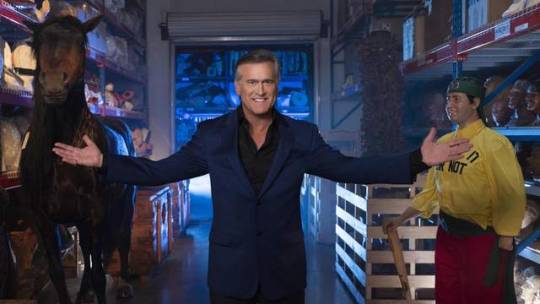
From Evil Dead, to Believe ir of Not: A Chat with Bruce Campbell.
This interview covers working with Sam Raimi and film-making in general.
It is hard to deny the impact Bruce Campbell has had on genre cinema. From the humble start working on the Evil Dead back in 1981 to his countless film and television roles, Bruce Campbell has made a name for himself, and a legacy that everyone in genre cinema has to respect.
Now, with him moving onto Ripley’s Believe It or Not CGMagazine got to be part of a round table interview where we got a chance to touch base with the iconic “b-list” actor to talk about his career, along with the industry of film making as a whole.
Perhaps his most endearing performance, even after over 30 years, is his portrayal of Ash. With three films and a series under his belt, he has made the character his own. His portrayal has led to numerous parodies, and countless takes and iterations on what that type of character is within horror. Yet, even the time, and new horror coming out almost daily, few can touch the timelessness of Ash.
Even with the show over, the legacy of what The Evil Dead means to fans will always remain. It is a series that stands in the pantheon of horror, cementing Bruce Cambell and Ash as staples of genre and cinema as a whole. Even with this, many questions about if the series got the ending it deserved, but it seems Bruce Campbell feels they sent the series off in the best way possible.
“I’m fine with it heck because we got to finally do it.” Campbell explained in response to his take on the legacy of the series “I got to, to address it to my maximum abilities right now. And I felt that we did that. And I felt we honoured the fans too. Because we gave them a pseudo ending. They will never be happy with anything that we do. But in this case, we were like, okay, we don’t know if we’re going to get cancelled or not. Let’s go come up with let’s make sure we end this particular season with something that could be considered an ending. So that’s what we did. And thank God we did it. Because we get canned. So if we didn’t do that ending people would be going, where is Ash? What happened. So we took care of that business.”
With the fact, the show is now over, Campbell can finally step back from the role of Ash. While an iconic character, and one he enjoyed playing, it is taxing bringing that character to life, especially on a show that pushes you both mentally and physically.
“It was painful. I pulled another hamstring,” Campbell said diving into the strain on his body while doing Ash vs.The Evil Dead. “There’s a series of embarrassing emails to Rick Jacobson, Season 2 I think where the episodes kept getting bigger and bigger because things are coming to a head storywise and there are all these fights, falling and all the worst crap. So there’d be these emails of ‘Hey Rick, I woke up this morning and I’m not sure if I can run today, can you make sure my stunt guy Raicho Vasilev is ready to go?’ Then the next day, ‘Hey Rick, my left knee is kind of fucked-up, can I just stand over the guy?’ I was falling apart. My whole body was disintegrating.”
Even with The Evil Dead now over, it is hard to deny the connection Bruce Campbell and Sam Raimi have. Old high school friends, and having worked with Raimi on many features, including the Spider-man franchise and Darkman, the team brings great chemistry to the silver screen. And even after all these years knowing each other, Bruce Campbell still enjoyed working with Raimi.
“I think Sam is the best director working,” Campbell outlined responding to the question on why he likes working with Raimi so much. “He’s one of the best directors in the business, probably top five as far as technical abilities. Watch Spider-Man 2. I think it’s one of the best superhero movies period and it’s the best of the trilogy. He’s really amazing at exponential learning. What he learns from one movie to the next technically. Like, he actually read the American Cinematographer’s Manual. You want to read stuff that will make you want to hang yourself with technical information about apertures and film speeds? He read it! He’s like ‘I think I should know how a camera operates because as a director that’s my tool. How can I use apertures and exposure to get a certain look or dynamic?’ That’s what’s fun about working with Sam.”
With many horror films looking to revive practical methods, people that love classic horror are happy to see what can be done by blending the two methods. With his countless years in the industry, and has worked on plenty of practical and CGI based movies, Bruce Campbell does not mince words discussing the trend to push CGI whenever possible.
“CG had to run its course. Because everyone was fascinated with CG “Oh, let’s just do CG.” But the problem of CG is it would spray off and defy optics, like a creature, would be here and frame one, frame three, It’s right in front of your face. So to the point where our eyes can’t even adjust because the optics are not correct. So they had to kind of work that out. And then they had to come to the horrible realization that special effects could not be the actual story.” Campbell explains when responding to a question about the revival of practical methods in genre cinema. “What does he mean we have to have a story. Hopefully, they’re coming around to the realization that effects can be used very effectively to tell a story like Forrest Gump.”
“So, when you watch that movie, they made special effects work to tell the story of a single feather flipping around during the opening sequence and it lands all the way at Tom Hanks’s feet looks like a real feather. floating through the sky landing at his feet was a pain in the ass to do that opening sequence. But the point is the digital process can really help you tell a story, but it’s not the story. I mean, once you see a superhero, throw another superhero through one building, eight buildings, ten buildings. It doesn’t matter. That’s not the story. ”
Along with being a renowned actor, Bruce Campbell also has a best selling book, one that is a great read if you have the time. While working in both realms, it is no wonder he has a view on how they differ and how Hollywood could learn a thing or two from the world of publishing. “The writing world is very respectful compared to the film business. There are very few chefs when you write a book,” Bruce Campbell explained “I addressed my editor’s changes for my latest book in about 15 minutes and if I wrote a screenplay I’d have 10-pages of single-spaced notes from some 26-year-old kid who doesn’t know shit, but they feel like they got to justify their job. It’s good to do different stuff, you get exposed to different people too. Making a book is a whole different story than making a movie. It’s kinda cool, the difference.”
While his days of picking up the chainsaw as Ash may be over, he is now stepping into the role of host for the new Ripley’s Believe It or Not! on the Travel Channel. It may mean less zombie killing, but is looking to be just as exciting for fans of the new and bizarre. Hearing Bruce discuss it, this is looking to be an exciting season of the show while keeping the legacy it has built over 100 years.
18 notes
·
View notes
Text
Movies of Fall/Winter 2019 (and 2020) that I’m really excited to see
With awards season kicking in, the movie release slate is about to bring us some incredible pieces of cinema. There are many films this year that sound fun, interesting, profound and promising so here is a shortened list of the ones that get me giddy with most anticipation. TOP 5 let’s go! (and a few honourable mentions)
5. Lucy in the Sky (Noah Hawley, December 6th, 2019, UK)
Randomly stumbling upon its trailer on Youtube, I was surprised as to why I haven’t heard anything about this film at all because it actually looks super intriguing. Even though the notion of a space movie can feel fairly worn-out, and there is only so much originality you can bring to that kind of concept, Lucy in the Sky looks like it’s going to be a completely shifted take on space dynamics and exploration. In fact, it seems it’s going to be a story fully centred around one character’s individual, self-reflective, very personal journey, with space acting only as a narrative device that creates the background, rather than it being at the forefront of the film’s events. Natalie Portman seems completely in her shoes in this trope of a study of a character who’s deeply damaged and emotionally transformed by whatever trials she undergoes. The trailer is put together so perfectly as well. It tells just enough information for us to understand what is the movie’s premise while also creating a dramatic and suspenseful energy. Also, to me the imagery feels very grounded and serious but also kind of weird, daring and eccentric in some shots, so if the creators managed to balance a kind of art-house approach with some epic, grandiose visual elements it is going to be one hell of a film. To be fair, I was kind of excited just ‘cause it’s Natalie Portman but the more I think about the story the more interesting and promising it sounds. Unfortunately, it comes out October 4th which means its going to have a biiiiit of a competitor in the box-office in the form of Joker.
4. Jojo Rabbit (Taika Waititi, January 3rd, 2020, UK)
This one exhibits several traits that make the film very enticing. First of all, of course, the subject matter. I think it’s fair to say that a little boy interacting with Adolf Hitler in the shape of an imaginary friend is as crazy and amusing an idea as it gets. And, of course, many of us have our understanding and reaction towards the people and events of the WW2 era but to have that portrayed in a comedy genre is definitely going to cast a whole new light on the subject, at least as seen on the big screen. This will most likely be a story exploring harsh realism through imagination and fantasy but also through the earnest and innocent eyes of a child and it will likely be a surprising take and not what anyone expects it to be. Due to many reasons, it is, obviously, going to be a widespread conversation piece and for that alone I have to see it. The other thing that perfectly complements the idea of this project, is the man himself, Taika Waititi. I don’t think a better combination between the material and the creator can emerge because it is hard to imagine someone else taking on such a bold proposition. He’s just the type of writer and director that is so unique in style and taste that you just believe anything he makes is going to turn out special in one way or another, and having creative will and freedom and integrity might be exactly what made this whole thing possible in the first place. Plus Waititi himself is playing Hitler which, I’d imagine, just raises the scale of humour and energy and dynamics of the whole piece.
3. Jumanji: The Next Level (Jake Kasden, December 13th, 2019, UK)
I know, a not so popular of a choice. Compared to the way every other film is awaited based on their technical and creative merits, with this one I am so genuinely eager to experience the fun. After all the amusement Jumanji: Into the Jungle brought to the franchise, I don’t see why anybody wouldn’t be excited about this next instalment. I absolutely loved that film, it was so so so funny and entertaining! The story was really great because not only did it bring that fantasy and adventure aspect once again but also the way the avatar/game player narrative approach was incorporated was so unique. So, after seeing the trailers for this sequel, it sparked even more excitement to see how else can they possibly spin that concept. With that in mind, bringing in Danny DeVito and Danny Glover, well regarded comedic figures and over all talents, to the mix is genius. Them trapped in the bodies of Dwayne Johnson and Kevin Hart is, honestly, a hilarious thought and having old guys interact with the other teenage friends and deal with challenges in the desert, jungle, mountain tops will be no less than a thrilling journey. I think this is going to be just the right film to kind of step back from all the serious and deep dramas that will be in full motion for Oscar season at the time, and switch to some good-old light-hearted cinema. With holidays coming up during its release (December 13th) - nothing better than to go see a fun family movie. And if the playfulness and humour combined with the fond spirit of the story lands at least the same way as it did with the previous film, it’s going to win over people’s hearts and probably the box-office. Can’t wait to just fully enjoy the action and immerse myself in the wonder of this adventure all over again!
2. Joker (Todd Philips, October 4th, 2019, UK)
I have to admit, while initially I was very interested in this new iteration of Joker purely on a general movie-goer level, it was maintained and gradually piqued as time went on largely due to everyone talking about it so much. The sheer amount of hype and anticipation this announcement has managed to create is baffling. Every film coverage outlet, magazine, blog was discussing it. And maybe it’s just that I follow a lot of superhero genre loving people and maybe the idea of this film, in fact, doesn’t concern the general viewer as much, still it has kept many eagerly waiting. The thing that gives it an edge, though, is the fact that this is not simply going to be your general superhero action blockbuster but rather an intense psychological drama reflecting on certain societal issues applied to a familiar mythology. The character everyone knows as a rival to Batman here seems to be a troubled man, beaten down literally, as well as emotionally due to social injustice and his own mental complications. Therefore, this film will probably not rely on epic showdowns and comic tropes as much but actually will give the concept of an ‘origin story’ a different meaning. It’s exciting that DC took it upon themselves to make a bold and creatively charged version of their beloved character, and with Joaquin Phoenix as the lead and Todd Philips as director I think they can be confident about their vision. Whether it is going to be received well or not, that’s the question. While it did already receive heaps of acclaim, including the Golden Lion in the Venice Film Festival, the early audience reviews are quite widely mixed. Nonetheless, it is very intriguing. I have to say, it’s shaping out to be one of those films, and performances, in particular, that have the ability to stay in the minds of the viewers long after. Not long to wait now and we’ll finally see if it lives up to what it set out for. ‘Cause let me tell you, the standard’s high, for sure.
Knives Out (Rian Johnson, November 29th, 2019, UK)
For the longest, this film and Joker were up to par for the number one place on my list of the most awaited movies of the rest of year. Every trailer amped up the excitement so much more and, ultimately, when I felt that I could’t stop thinking about Knives Out, counting days ‘till it’s release, I knew which one has won me over. No surprise, though. I absolutely love whodunnits!!! There’s just a certain thrill to a mystery or a detective style film that cannot be found anywhere else. There’s always so much room for exploration of characters and narratives and the story can take so many directions. If a screenplay for a murder mystery is done right, and all the twists and turns are unexpected and smartly placed, it’s just the best. I also love the interactive aspect of it. Even though I know I can’t change the way it all plays out, I have the ability to have my own reasoning and conclusions that I can apply in my head as the events role out. So with this film I was instantly hooked. Chris Evans’ attachment to the project definitely helped me discover it, though. I’m a huge fan of his and I was curious already to see what kind of role he is about to take on next after the culmination of his journey as Captain America in the MCU. Since I find him to be a very intelligent actor, I think I can trust his judgement on what kind of material is interesting to explore and what kind of people are worth collaborating with. That in mind, this cast looks absolutely incredible! Some really experienced ‘veterans’ in Toni College, Jamie Lee Curtis, Christopher Plummer, a big big star Daniel Craig, as well as some less known but promising names such as Ana de Armas and Katherine Langford, for example. And that’s just to name a few… Wow. With the nature and genre of the story, given it’s a suspenseful mystery but with a comedic flare, a good ensemble of performers is crucial, as is their dynamic. Hopefully, writer/director Rian Johnson has managed to create a rich, powerful and unique film that will entertain and won’t disappoint. I do believe that will be the case, as that much talent on screen and behind the camera is usually a recipe for success.
If not for the short list… I have so many other films that have caught my attention and that will absolutely have me in the cinema seat on opening night. These include Bombshell whose team is worth an applause for that amazingly well put teaser trailer; Just Mercy, for a true story that will no doubt have an impact on me and for what seem to be astounding performances by the lead cast; and Marriage Story because it will make me cry… Stories about family, love and relationships always hit close home, this one might break my heart but there’s pain and joy in life all the time, I look forward to seeing the often difficult reality reflected on screen.
#featuristic#featuristic film#movie thoughts#films#movies#cinema#comedy#drama#mystery#action#superhero#entertainment#hollywood#oscars#award season#upcoming films#cast#director#lucy in the sky#jojo rabbit#jumanji: the next level#joker#knives out#long post
10 notes
·
View notes
Text

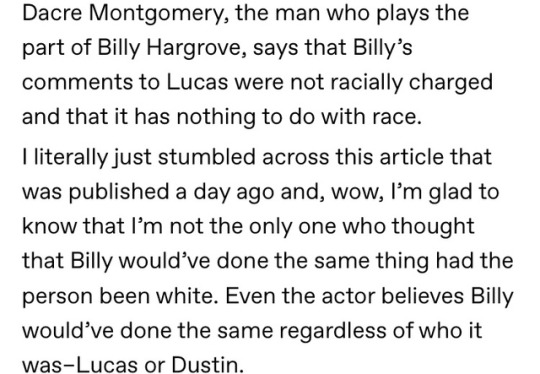
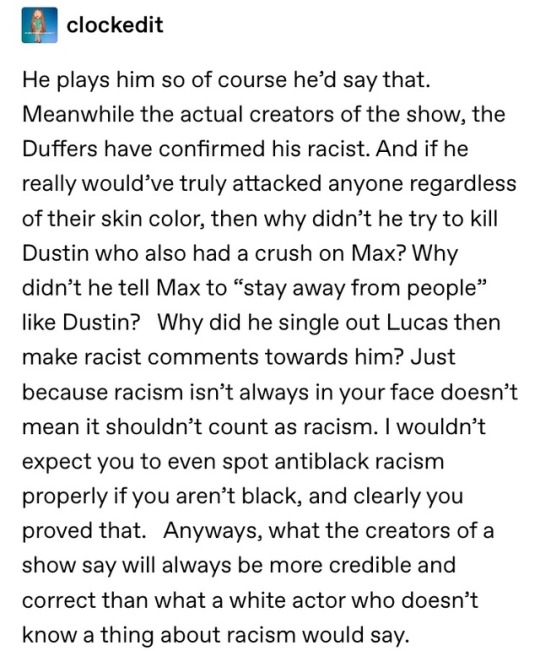
Well, I would like to say I thought this through before dragging this post back up after having posted it way back when ST2 was new and fresh out of the proverbial womb, but, the harsh truth is, I did not. Honestly, I have been ignoring the existence of this post since its conception because the amount of popularity it garnered was mainly negative (no shock there; this is, after all, tumblr) and I had more important things to stress over than what someone interpreted from a line in a show that will fade into obscurity in a couple of years. However, the most recent reblog caught my eye because someone actually wrote something under it—and not just under someone else’s words, but the original post, which I had not seen in a while.
Obviously, what they said did not make me very happy. Otherwise, what is the actual point of making this post?
Here is the thing, the “tea” or however you want to call it—everything they said is way out of line.
I will be the first, the very first (no one is beating me to that spot) to admit that the original post was just a little bit tone deaf. It did not really discuss the topic or why it is that I felt like I did or Dacre’s own opinion. It was just a couple of screenshots from an article that made me feel better about where I stood on the whole debate—and I wanted to share it. I don’t know why. Maybe to just not feel crazy in the midst of that drama? Who can say? However, I will be the first to say that the post is wholly inadequate in explaining anything of note.
I was not exactly surprised when people took to it with raised hackles, even if I really never conceived it would reach close to five hundred notes by the time I got the guts to address it again (and I know that five hundred, 5-0-0, doesn’t really seem like a lot, but considering that I thought maybe one person would pay attention to it, it’s basically the equivalent of a million in my eyes).
But, you know what? I’m tired. I’m stressed. I’m slowly dying. Let’s finally addres this. Because this reblog, this most recent reblog, really bothered me. And I know, trust me when I say I know, that it seems simple and of no need for concern, and I’m sure the few people who are actually bothering to read through this are thinking, “Why on earth did they not just talk to this person instead of making a long post?” But, here’s the thing with this whole shebang: I’m tired, and this person isn’t alone in their opinion. What made this one stand out is how they phrased their belief.
I’ve had to listen to people gripe about how this post “proves there’s no such thing as POC solidarity”, and they’re absolutely right because Native American woman are being slaughtered and raped and abused every day, and Native Americans are represented less that one percent of the time (<1%) ) in film and media (and the few, very rare, times they are it is with an abundance of racism and stereotypes piled onto them), and yet I don’t see black people, with their sixteen percent (16%) representation score raising much of a fuss. (This is not a call out or something. I get it. Get your own representation and rights before helping out anyone else. It makes sense, in a way—I’m not judging. But maybe don’t come at people with that when you’re part of the issue.) I have had to listen to people assume my race, ethnicity, political leaning because of this post, and, honestly, I’m just a wee bit tired of it.
I have four things I really want to say with this post, in response to everyone, but especially in response to this one reblog:
1) I am a proud person of color. I am a proud descendant of African slaves. I am a proud descendant of Taino natives. I am a proud member of the Latino community. I am a proud non-white individual who experiences racism on a daily basis.
I experience racism meant for black people. I experience racism meant for Latinos. I experience xenophobia meant for Middle Easterners and Asians. I experience racism meant for Middle Easterners. I experience racism meant for Indians. I experience Islamophobia meant for Muslims. I have been told they should “build a wall” to keep me out. I have been told that the KKK should pay me a visit. I have been called a terrorist. I have had people dance in crude imitations of Indian traditional dance to my face while laughing. I have experienced all of this and more.
I have been a victim of racism, classism, sexism, homophobia, xenophobia, etc., from both POCs and white people, straight and gays, natives and immigrants.
Do not presume to know my race and my experiences just because my opinion does not coincide with yours. Quite frankly, don’t do that to anyone. You do not know anyone’s life story, especially over the Internet. Do not assume otherwise. Do not delude yourself into a false confidence and assurance of your own moral superiority when you know nothing of the people you are attacking. It is easy to hide behind a screen, and I am not here to tell you to not talk about what you wish and what you can and cannot talk about and direct at people. I merely suggest you stick to the information readily accessible, not mere assumptions based on your own prejudices. It reveals more about you than the person you are belittling.
2) Billy never saw Max and Dustin together like he did Max and Lucas. Billy never saw Dustin upsetting Max like he did Lucas. Billy never sees Max and Dustin in any capacity like he does Max and Lucas.
This is not a justification. This is not an excuse. This is a mere statement of fact. Whether or not you believe Billy is racist or abusive or whatever, the bottom line is the same. Billy doesn’t witness Max with Dustin like he does Lucas. Honestly, I’m fairly certain Billy never even sees Dustin and Max together at all. Think Billy is racist or don’t, but it doesn’t change this very basic fact. It’s not a situation of “why didn’t he” when every iteration can be debunked by simply understanding that this wasn’t information he was privy to ever. “Why didn’t he?” Because he didn’t know.
3) I don’t take the word of the Duffers on anything. Let’s make that perfectly clear. And this is not some personal dislike or something. This is born from experience. I have sat in the writer’s chair; I have sat in the director’s chair; I have sat in the actor’s chair. You know what I have learned? The writer provides the skeleton, the director gives it movement, the actor gives it life. The job of an actor is solely to understand the character. That, ladies and gentlemen and the general populace, is the secret of acting.
What the writers provide is just the guidelines for the actor. The understanding the actor develops can evolve into a different interpretation than the writer or director had, and it has the potential to be more profound.
The other two reasons I don’t take the word of the Duffers on this is: A) had it not been for Dacre, the Duffers would have been subject to critique on lazy writing moreso than they are already because Billy’s depth and complexity, especially the jarring scene we all remember, came from Dacre—Dacre wanted a villain with a reason if he was going to play Billy and he pushed for it (which says a lot about him and how skilled of an actor he is—understanding that experience and trauma shapes us and forms us into what we are and that we are not static beings, so there should be no such thing as a static character) and that makes Dacre’s opinion a lot heftier than the Duffers’ already——B) Dacre originally did think Billy was racist. Isn’t that a kicker? Dacre remarks in interviews that when he read the script at first, he thought, “Oh, no, gosh, he’s racist on top of all of this?” And he stayed with that mentality for a bit. It was only as he delved deeper into the character and understood Billy more as a person instead of the two dimensional villain he’s set up as that he changed his mind and came to the conclusion that he doesn’t think Billy’s racist.
He put in the work.
The Duffers went in with a throwaway line and labeled the character as racist. They wanted a human villain, someone for people to hate, someone to pit against our heroes, against Steve. They wanted to make him awful and static and to have him do what Steve’s character couldn’t and stay the asshole the audience could hate.
Dacre didn’t fall prey to that mentality. He searched for the human in the label “human villain” that the Duffers wanted and found a much more complex character than the Duffers even considered. Because of this, Dacre’s opinion carries far more weight than the Duffer Brothers’.
And, ultimately, most importantly—the main reason I wanted to make this post, to defend the original post this is born from even though I’ve stated my stance on this issue in a separate post in much clearer terms—the real reason I made the original post to begin with even if I never talked about it:
4) People who immediately assume racism instead of ignorance, racist instead of ignorant, are part of the problem, not the solution.
This really bears no explanation. You cannot change what you believe is irreversible. You cannot educate what you believe is closed off. You cannot help that which you’ve condemned.
I do my utmost to live my life by this. Ignorance before condemnation, always, always, always. The majority of the time it is a lack of education on the subject and a lack of personal experience that leads to such grave misunderstandings. Give a person the chance to learn and to be taught and to redeem themselves, and most of them will. It takes time and patience and a boatload of energy and perseverance, but you get there through understanding and the willingness to help out—by giving them the chance everyone else is denying them.
You cannot help those which you’ve condemned. In life and in fiction, until proven repeatedly over and over again when intervention is applied, I like to adopt the philosophy that people are ignorant before they are racist, before they are a sexist, homophobic, xenophobic, etc., etc.
I’m not saying it’s a popular philosophy (because it’s not), and I’m not saying it’s right (because maybe it isn’t), but it’s my philosophy. And knowing where Billy comes from, what he’s been through, who his father is, what his home life is like, I elect to believe in my philosophy and in my understanding of the human mind, and I don’t think he’s racist. I can definitely see how he might be construed as such, and I don’t belittle those who see it that way, but I stand by my original observation (however ineloquently stated) that I, in my own personal opinion, don’t believe Billy is racist.
And, ultimately, I just want people to accept that. I’m not denying the possibility. I’m not uninformed. I’m not some white, cisgender, hesterosexual man sitting behind his computer screen agreeing with a white actor because it makes me feel more comfortable in myself and my own experiences. I am a proud POC, a proud member of the LGBTQ+ community, a writer, an actor, a director, and a human being. I see where you all are coming from—I hear you; I read what you write. I get it. But can you get me? Can you understand where I am coming from? Can you stop with the misinformation and the moral superiority complex? Life is too short to live like this. I know that it’s Tumblr. I know being superior is the bread and butter of this site. But, honestly, guys, let me get cheesy for a second, let me get real, because you guys clearly need to hear this:
Be willing to understand and to learn. You will get so much further in life. You cannot help that which you’ve condemned, guys. And you really can’t. You can’t change what you believe is irreversible. You can’t teach that which you believe is unwilling to learn. Give people a chance, and they might just surprise you.
Gosh, I hope this cleared some things. I doubt many of you made it to the end if you even got past the beginning, but I sure feel better after writing this. Take care. Bless. I’ll see you on the other side of the war.
#stranger things 2#billy hargrove#in defense of billy hargrove#in defense of myself#dayummmm never thought i’d end up here#tumblr will forever and always need to chill#chill tumblr chill#mullet wearing asshole#harringrove#i am here to clear the air#that really wasnt muggy to begin with#but some people got confused real fast#so here we go
17 notes
·
View notes
Link
SPOILER ALERT: Do not read until if you have not yet watched the season four finale of “Gotham” on Fox.
The final moments of the season four finale of Fox’s “Gotham” essentially rebooted the series, with some characters leaving town, multiple villains rising from the underground and one series regular signing off for good.
In the episode, Solomon Grundy (Drew Powell) was shot but then healed and seemingly returned to his normal Butch state, only to be murdered by Penguin (Robin Lord Taylor).
Powell tells Variety after first learning he was going to be shot again, he wasn’t that worried. “This is the fourth time I’ve been shot on the show,” he notes. “Clearly I can survive a bullet wound.” But what made this one different was the fact that he got shot in the heart.
“[That] would probably take another dip in the Slaughter Swamp to recover from,” he admits.
Here, Powell shares with Variety the emotional moments while filming his final scene, what he will miss about playing the character, and if he would ever join the DC Universe again.
How did you learn that Butch aka Grundy wouldn’t make it to the end of the season finale?
I kind of found out by accident, if I’m being honest. I was at work. The process of Grundy is always a couple hours of make-up coming on and a good 45 minutes to take it off. So, I’m usually there before people and there after people. I was in the makeup room, and I read an outline, which sometimes you do. I don’t know if we’re supposed to do that, but any actor that says they don’t is lying. I glanced at it and I kind of got to the end and it said, “Blah, blah, blah and then Penguin shoots Butch in the heart.” I’m like, “Ooh, that doesn’t sound good.” …I called up [executive producer] John Stephens and he said, “Ah, well. I was just about to get on a plane to come tell you tomorrow,” which he did — I saw him the next day.
How did it feel to know you wouldn’t survive the season?
It was a mix of a lot of emotions. Obviously I’m so close to this group. This show has really been an important show in my career. I moved my family from one coast to the other. I’m now kind of forever linked in this really cool world of DC and Batman lore. It’s really special for me. But the cool part was that the overwhelming feeling I had was not anger or resentment or sadness — although there was some of sadness — but it was gratitude. I just felt so grateful that I’ve had four great years of this. Look, who knows what’s to come, but I can feel like I’ve done good work and had a great experience.
How do you think you’ll feel after the episode airs?
It will be very interesting to feel the catharsis of this coming to life and how people will react. It’s been very interesting the last couple of weeks. “Gotham” did a poll of which character they liked better: Butch or Grundy. I didn’t see the final results but with a day left it was 50/50. It was absolutely down the middle. That warms my heart. It was risky on the same level to take this. I believe what people love about Butch was that he was kind of the every man in the scenario. You have crazy Penguin, nutty Riddler, and all this craziness going on. Then, you’ve got the cops that are stern and hard. Then you’ve got Butch who has managed to survive in this crazy town. He ducks and weaves and survives and does it with a little bit of humor and a wink and smile. I think that was really important to have in this show. I think when Bruno [Heller] wrote this character, he told me at the beginning, “People are going to underestimate Butch until it’s too late for them.” It was really true. Even the fans were like, “Oh, he’s just some henchmen for Fish.” Then by the end of season one, they were like, “Oh my gosh. No, he’s way more than that!” It’s going to be really interesting to see the fan reaction. It’s very shocking. I would love to have a camera on fans watching that scene. I do think the reaction will be physical for a lot of people.
How far in advance did you know before you shot the episode?
That was the other tricky part. I was in the middle of shooting 4.20 (episode “A Dark Knight: That Old Corpse”) so we still had two more episodes to go which equals about a month. So I had three, four weeks of dealing with [it]. I think a lot of actors will tell you when you end a long-term job that you really like –particularly, because people feel like we’re a tight group, especially as actors but also crew — you have to go through the five stages of grief. By the time we actually got to that scene, I had been living with it for almost a month. I have to be honest when I say it’s been really tricky. It’s been a long haul to have a month before we shot it. Then we shot it — that was the beginning or middle of March. So I’ve been sitting on it to most of the people outside of my close circle for the last few months, so it’s been a long haul. There’s a part of me that will be very relieved as this comes out.
When did the rest of the cast find out? Did you tell them?
That was kind of a weird thing. Some of them, yeah. There were a couple people I saw the next day that were working the next day so we talked and grieved together a little bit. I don’t mean for it to sound so dramatic. It was definitely a bond that formed so you have to deal with that. But I think people found out through word of mouth. I told some folks, but it was kind of awkward. There’s no real easy way to do that. It’s been true for the other characters that have passed on from our show. It’s all a little bit awkward. But that was the good thing about having time. By the time we got to the end, we had all talked about it. There was a sense of closure on that last day.
How was it filming the final scene and having Penguin be the one who offs your character?
I’ll never forget it. I don’t think any of us will. It’s a beautiful scene. The one thing I said to John Stephens when we talked was what was most important to me was that we need to give Butch a proper death. I think [the] words actually were a “noble death,” and he agreed. Not some cliffhanger. I think the fans, who’ve really grown to love Butch as I have — and Grundy — [would want] a proper send off for him. I think they did that. I was kind of dreading it. We finally got there. The director was Nathan Hope, who’s just a great guy and one of our favorites on “Gotham.” …I don’t think we ever did it without crying, even Jessica [Lucas], who is way tougher than Robin and me. It was just so emotional and so hard. Robin and I are very good friends and have been since the very beginning. So, it was hard for him. It was hard for me. Jessica, as well — those are the guys I’ve spent the most time with over the course of the show with the exception of Jada [Pinkett Smith]. It was really powerful. It was a moment where we had a culmination of this incredible life experience. As an actor, it’s hard to separate [from] that because it changed my life. That’s true. I think it’s true for any actor that has a job that like that moves you from one place to another and you have over a period of years. But also the relationships and the emotion of the scene. I think Robin and I have always had this chemistry that was really special and it really made the Butch and Oswald scenes work. I was really glad to have a few more of those toward the end of season four. By the time we got to that [scene], he was crying and snotting, as he will admit. Jessica had some tears. Then, I’m dead on the ground with tears streaming down my eyes. We got through it. I haven’t seen it, but I’m hoping it cut together OK. We felt like we got it in the end.
Penguin apologizes before he shoots Grundy. Do you think he was being sincere?
I think the wonderful paradox about Oswald, particularly as Robin has brought him to life in this iteration, is that he is at once an emotional character, a passionate character, but also calculating and smart. He’s always three steps ahead of the game. I think after losing so many people that have been close to him and then I think his experience with [Edward] Nygma, the one thing he won’t let happen anymore is to let his emotions get in the way of what’s important to him which is revenge and power. It’s funny. We’ve talked about this. The fact that Tabitha [killed] Ms. Cobblepot was never going to sit well with him. He wanted to get back at Tabby for killing his mother, the most important thing to him. I always assumed that she would be the one to get it and not me, but I guess I had to be the proxy in this one.
What was the hardest part about saying goodbye to Butch?
It’s funny because I’ve said goodbye to him once. That took me by surprise. There was a moment after we did the Grundy scene — in episode five of the season, they dump Butch in the swamp and Grundy rises out of the Slaughter Slump. The way we shot that out in a pool in the middle of nowhere in Staten Island, we did the rising out of the swamp scene and then hobo scene, and then the last scene we shot was Butch getting into the swamp and then they kind of pulled me out of the water. So that was like the very end of Butch, at least at that point. I was surprised. [For] three years I’ve really grown to appreciate this character. Not often do you get that opportunity as an actor. One of the things I love about TV is that you can live with the character for a while and kind of inhabit him or her. I really did that with Butch. We’ve had a lot of different paths on this particular show. I surprisingly felt a sadness of losing Butch. Then, Grundy presented his own challenges. The makeup alone was something that really took some getting used to. There’s part of me that thinks another season of Grundy with all of that makeup and that wig and the whole thing would’ve been pretty tough. But I loved him too! The death of both characters at once [in the season four finale] was really emotional. It was emotional for all of us.
What is one thing you’ve learned since the start of “Gotham” that has helped you grow as an actor?
I think the experience has taught me to prepare. Not that I didn’t before, but the importance of thinking about what you’re doing [and] understanding that there’s an arc here. That there will be an evolution throughout time. It took me a while to kind of get the knack of who Butch was. To spend time in thought and contemplation and study of who this character is so that you can really bring him to life. I learned how cool it is to be a part of the world of comic book characters — the DC world, the whole general genre. I hadn’t had that experience before and getting to do some of these comic-cons and meeting fans that are so passionate and being a part of something that’s 75 years old — this American mythology — is really cool. That’s one of the things I loved about being Grundy, too, was to be a part of the canon, which was a creation by the brilliant Bruno Heller. It was great to be able to create that role. I secretly hope someday, somewhere there’ll be a Butch Gilzean in a comic somewhere. Being able to be this iconic villain, or anti-hero as I like to think of him, who started in 1944, boy that’s a legacy that it’s so neat to be a part of. That was really special. Also, you get to practice with incredible people. You get to do it over and over with really talented crew members and directors and writers and cast. I think that last part is the thing I’ll miss the most — the camaraderie we had. We’re like a family. I think about our trips to comic-con in the last couple of years in this plane together flying out and the laughter and the stories that we’ll have forever. That doesn’t happen on every show. I’ve been on a lot of different shows and you have sometimes different personalities that just don’t click. But for whatever reason, this group of people really did, and I’ll forever be grateful for that.
Would you take on the role of Butch again or another character for a DC film?
In the blink of an eye. Absolutely. Having said that, the last three months, I did the pilot for “L.A. Confidential” which was amazing. I did a couple of movies — the movie I’m doing now is about Ted Kaczynski. So it’s been fun to kind of explore other things. That’s something I feel very lucky to have got to do right away to kind of help clear my head a little bit and know there is life after “Gotham.” But of course, I’d be a fool to say no to getting back into the DC Universe. Every time I see Geoff Johns I’m like, “I’m in, for my career! Whatever you need, I’m in!” Not the least of which is I’m the father of a 7-year-old boy, so I get to be the coolest dad in the world since I get to work with Batman.
The finale ends in a way that could reboot the series. What were your thoughts when you first heard about the decision to potentially switch-up the show?
It was never really made clear to us that that’s what was happening. Not having seen the episode yet, I’m still unclear, other than what I’ve read, about what that really means. A good friend of mine, John Rogers, a writer and producer who I’m very fond of, tweeted that we’re getting to a point where we’re going to have to accept the fact that series are basically going to be five years and that’s what you’re going to get. I think he’s right about that with a few exceptions. You get to a point in storytelling in our society today which expands looking for the next shiny object or light button. Even something serialized like a comic book show which you feel like could go on forever. It’s also hard to shoot that show. There’s a lot that goes into it. This isn’t your procedural point and shoot and talk about whatever cop lingo is it — there’s a lot going on there. So, I understand the need to kind of give it a little jolt and see what happens.
#Butch Gilzean#Drew Powell#Solomon Grundy#Oswald Cobblepot#Robin Lord Taylor#Tabitha Galavan#Jessica Lucas
86 notes
·
View notes
Photo

Overboard (1987)
Amnesia and romance are old companions in narrative art. Garry Marshall’s Overboard is one entry in that long-standing relationship beset with clichés and predictability. Overboard, too, dabbles in those same clichés and is also a bit predictable. Nothing about this film is surprising. But what elevates Overboard above many of its 1980s romantic comedy peers is the natural charm of its central performances and its delightful jokes. The film stars Goldie Hawn and Kurt Russell in the real-life couple’s third and most recent film together – after Swing Shift (1984) and The One and Only, Genuine, Original Family Band (1968; Hawn has a cameo) – and, by some distance, their best work together. The screenplay by Leslie Dixon recalls the great screwball romantic comedies of the 1930s and ‘40s (I’m not a fan of humor that combines cruelty and raunchiness, so this approach appealed to me) updated somewhat for the ‘80s. It all combines to comic, even heartwarming, results.
The heiress Joanna Stayton (Hawn) is the arrogant, haughty spouse of Grant Stayton III (Edward Herrmann). While their yacht is docked off Elk Cove, Oregon, handyman Dean Proffitt (Russell) is hired to remodel her closet. Joanna, giving no directions to Dean before he took the job, is furious when he uses oak instead of cedar. The two spout their frustration at each other, ending with her tossing him off the departing yacht without compensating him. Later that night, Joanna falls overboard, is fished out of the water by a garbage ship, and awakens in the hospital with amnesia. Dean, hearing about the news, has revenge on his mind, and seeks to have Joanna work around his house and for his four disorderly sons (Brian Price, Jared Rushton, Jamie Wild, and Jeffrey Wiseman) by posing as her husband of thirteen years. Joanna Stayton becomes Annie Proffitt. But vengeance turns into love, and Overboard handles this as compassionately and as respectfully any film that would attempt such a conceit can.
Overboard’s characters also includes Joanna’s mother, Edith (Katherine Helmond); the yacht butler Andrew (Roddy McDowall); and Dean’s best friend Billy (Michael G. Hagerty). Garry Marshall’s favorite character actor, Héctor Elizondo (who appeared in all of Marshall’s directorial works), has an important cameo as the garbage scow skipper.
Going into Overboard, the opening twenty minutes or so are like something from a Preston Sturges or Billy Wilder screwball comedy. The lifestyle porn might not be as flashy as one might expect from a gazillionaire family (if Overboard had the budget of a James Bond movie, Garry Marshall should have poured half that budget into decking out the yacht with ridiculous technology and 1980s gold-plated Trumpian/Gordon Gekko opulence), but the very fact that there is a yacht, several waitstaff, and a snooty couple always calls for a gate-crashing character. Enter Dean – so repulsive, so horribly dirty to Joanna – as the Sturges-esque everyman given a backwoods twist. As the foil, Dean schemes to exploit Joanna’s amnesia and to humiliate her – as someone who despises unnecessary nastiness in comedies, my internal klaxons were sounding – which may prove to be overwhelming for those who often feel for a character’s secondhand embarrassment Overboard dangles perilously over the chasm of Stockholm Syndrome, only to be saved by what Joanna brings to the narrative (I imagine some readers will disagree with me here, and that is fine).
Leslie Dixon’s (1993′s Mrs. Doubtfire, 2003′s Freaky Friday) screenplay assures that Joanna finds her own goodness by the force of her own nature. Dean hurls personal and physical insults towards “Annie” in the early days they are together, so she is finding very little solace there. The chores are backbreaking at the Proffitt household, with clothes, toys, and appliances strewn across the ground and on the furniture. She receives little to no help there but will become better at these chores she has never had to complete herself. The film’s harshest critics claiming that Dixon’s screenplay is undermining a strong female protagonist by having her endure all this abuse and discover herself through housework are missing the point – Joanna was never a strong character to begin with and housework is not what makes her transform into the woman she does become. Invoking one’s wealth to denigrate others – no matter how wittily, no matter how implicitly – is insecurity epitomized.
Where Joanna begins to find her own sense of belonging and inner strength is when she hears how the four Proffitt boys are being mistreated and talked about by their teacher. The sons have not been very hospitable to their “mother”, either, so one could say that Joanna – amnesia aside – has no obligation to help them. But she finds the courage and the words to stand up for the four boys in a way that their father never has, calling the teacher an, “anal, compulsive Hun”. She continues:
And my children may be rotten, but they’re mine. And I think that they’re bright and sensitive, so I have no doubts whatsoever about their intelligence.
This is where Overboard turns from its revenge plot and never looks back. She has forgiven her sons (no quotation marks needed there) for their countless flaws. As the film can find the inner beauty in Joanna, so too can Joanna see it in the four rambunctious children she is taking care of. This care, thankfully, is not a one-way street, as the children and even Dean realize that she is setting an example for them to follow, that there will be expectations even in forgiveness and an act of defense. After this point, the charms of Hawn’s and Russell’s chemistry finally pay off and pickier viewers can feel a bit more comfortable at laughing at the slob humor of the film’s opening half. They transform along with their characters as they learn when to give and when to take. The changes come gradually – there is never any instant awakening from Joanna; Dean has zero idea how to be a father to his sons and not just a friend. Where they may have been on different terms and opposing wavelengths before, they now commit to struggle together. When one notices those changes, the film’s sweetness is infectious.
As with any romantic comedy, good times will last (eventually), but there will always be a final interruption before the protagonists can resume with the happiness they have built. Overboard’s iteration of this is unsurprising (as are the entire film’s structure and plot developments), but comes with some concise, considered words from Roddy MacDowall’s character of Andrew (of course these lines were delivered by an outstanding character actor with a lengthy career mostly behind him). Together, director Garry Marshall and screenwriter Leslie Dixon may not have created the funniest – which I have not commented on much here because spoilers in movie reviews set unrealistic expectations on comedies especially – or even the most well-meaning romantic comedy. Do not think too much about John A. Alonzo’s mediocre camerawork and Alan Silvestri’s distractingly dated, banjo-and-electronics blended score and Overboard will be a pure delight.
An inconsistent decade of moviemaking disappointments and successes followed for Goldie Hawn as she became less comfortable with the changing winds in executive Hollywood and would begin to increasingly dedicate herself to her eponymous non-profit foundation. For Kurt Russell, a decade of masculine consistency with films like Backdraft (1991) and Tombstone (1993) helped shape the public persona he retains today. The late Garry Marshall continued to direct and produce comedic films until the end of his career. For Marshall, he considered Overboard one of the funniest films he ever directed. I am not one to disagree as the screwball familiarity of Overboard’s formula is helped by the earnestness of its performances and strength of its (eventual) messages.
My rating: 7.5/10
^ Based on my personal imdb rating. Half-points are always rounded down. My interpretation of that ratings system can be found here.
#Overboard#Garry Marshall#Goldie Hawn#Kurt Russell#Edward Herrmann#Katherine Helmond#Roddy McDowall#Brian Price#Jared Rushton#Jamie Wild#Jeffrey Wiseman#Leslie Dixon#My Movie Odyssey
7 notes
·
View notes